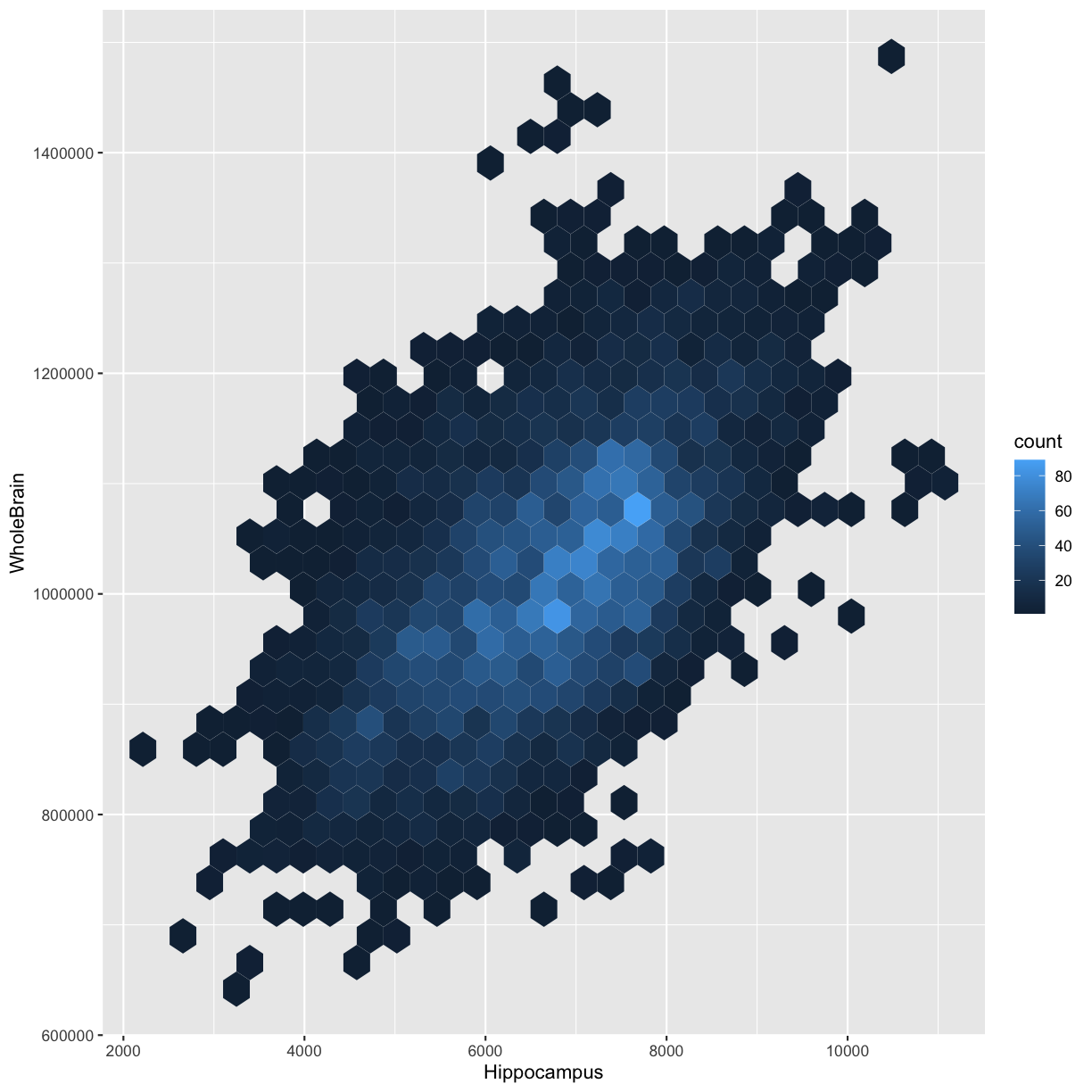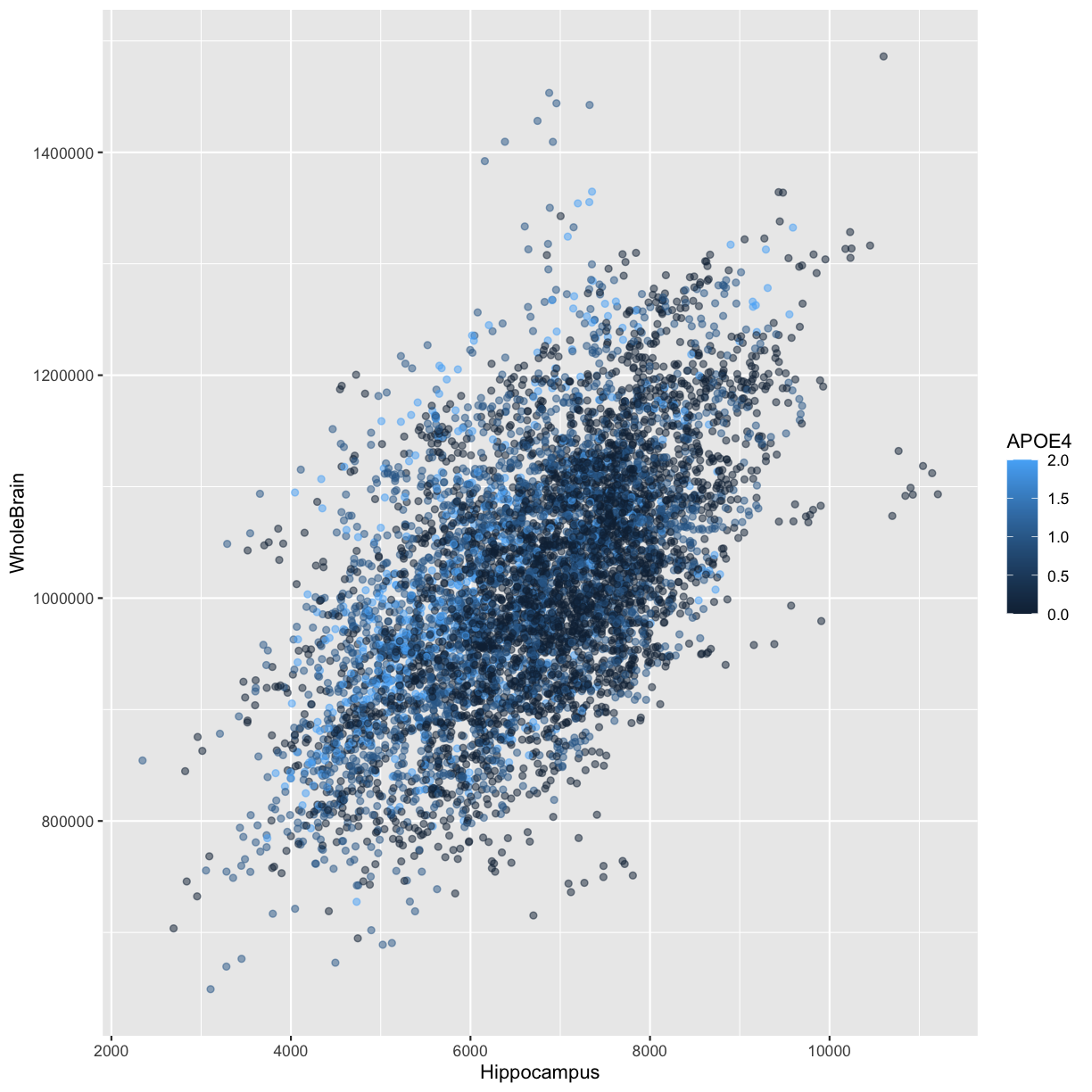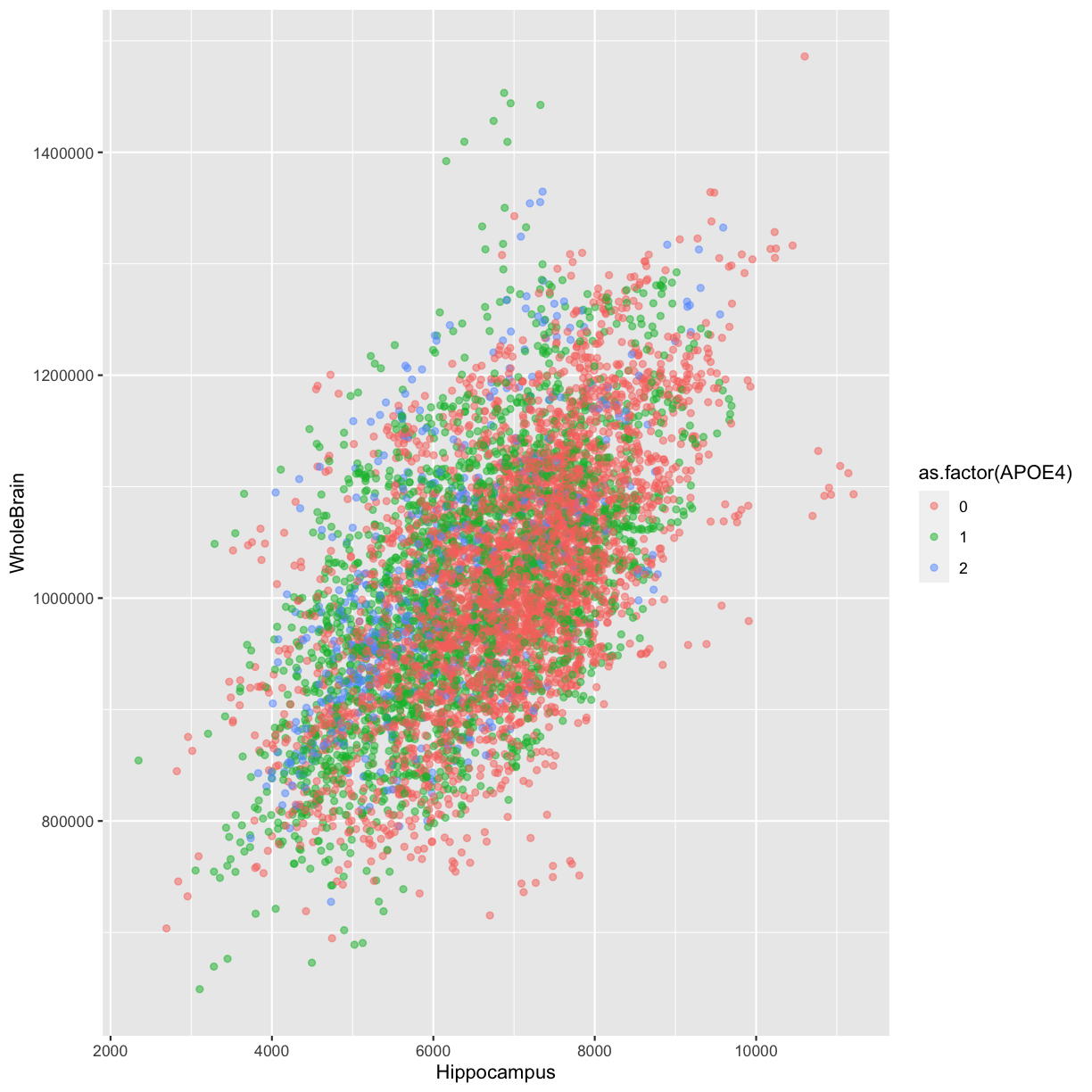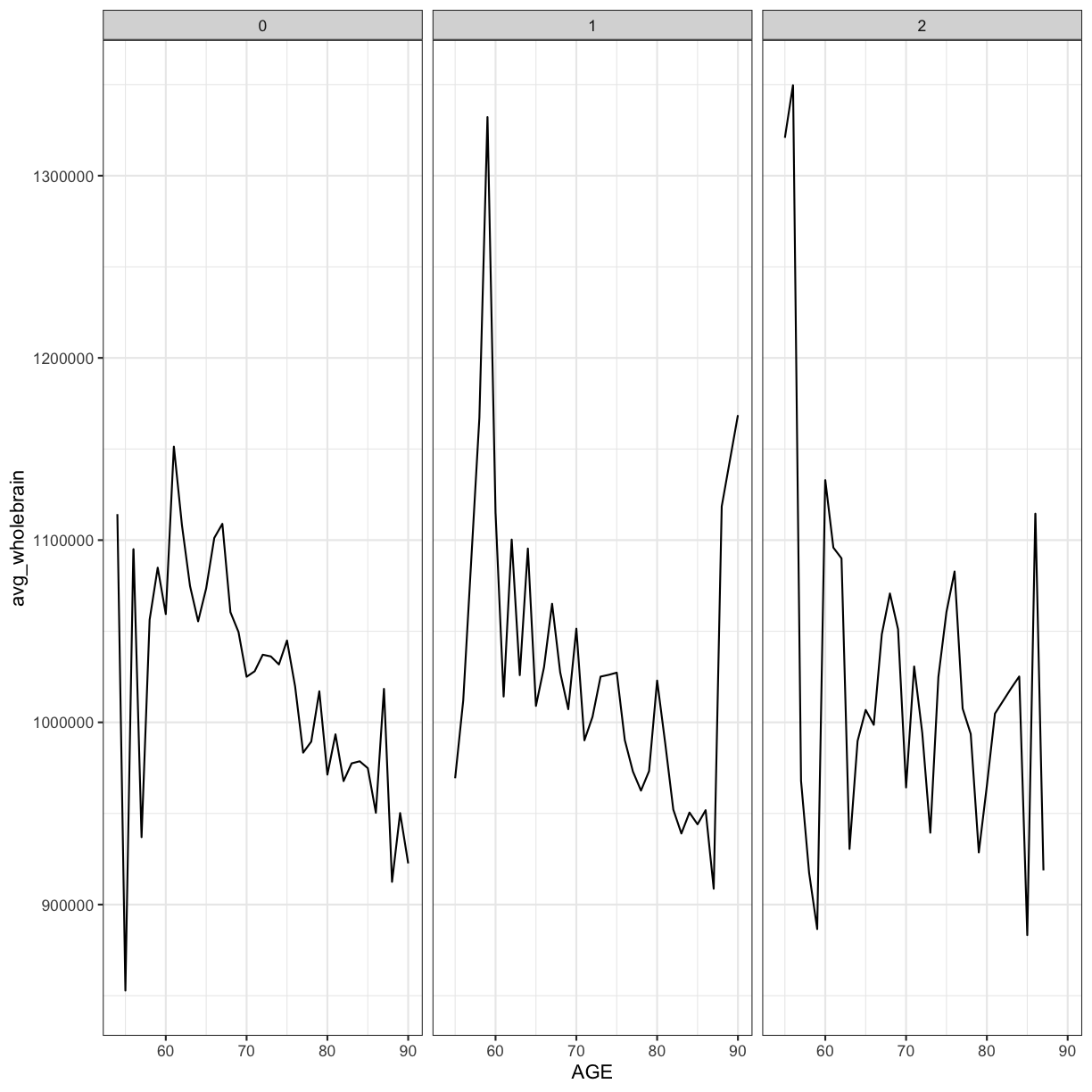Data visualization with ggplot2
Overview
Teaching: min
Exercises: minQuestions
How can I create publication-quality graphics using ggplot2?
Objectives
Produce scatter plots, boxplots, and time series plots using ggplot.
Set universal plot settings.
Describe what faceting is and apply faceting in ggplot.
Modify the aesthetics of an existing ggplot plot (including axis labels and color).
Build complex and customized plots from data in a data frame.
We start by loading the required packages. ggplot2 is included in the tidyverse package.
library(tidyverse)
Now let’s load a “cleaned” version of the ADNI dataset that lacks missing values into a
variable called adni_c.
adni_c<- read_csv("data/adni_clean.csv")
Plotting with ggplot2
ggplot2 is a plotting package that makes it simple to create complex plots
from data in a data frame. It provides a more programmatic interface for
specifying what variables to plot, how they are displayed, and general visual
properties. Therefore, we only need minimal changes if the underlying data change
or if we decide to change from a bar plot to a scatter plot. This syntax helps in creating
publication quality plots with minimal amounts of adjustments and tweaking.
ggplot2 functions like data in the ‘long’ format, i.e., a column for every dimension,
and a row for every observation. Well-structured data will save you lots of time
when making figures with ggplot2
ggplot graphics are built step by step by adding new elements. Adding layers in this fashion allows for extensive flexibility and customization of plots.
To build a ggplot, we will use the following basic template that can be used for different types of plots:
ggplot(data = <DATA>,
mapping = aes(<MAPPINGS>)) +
<GEOM_FUNCTION>()
Define the data:
Use the ggplot() function and bind the plot to a specific data frame using the
data argument
ggplot(data = adni_c)

The output is an empty plot because R has created a ggplot object with the data, but the user hasn’t specified how to plot it.
Choose x and y values:
Define a mapping (using the aesthetic (aes) function), by selecting the variables to be plotted and specifying how to present them in the graph, e.g. as x/y positions or characteristics such as size, shape, color, etc.
ggplot(data = adni_c,
mapping = aes(x = Hippocampus,
y = WholeBrain))
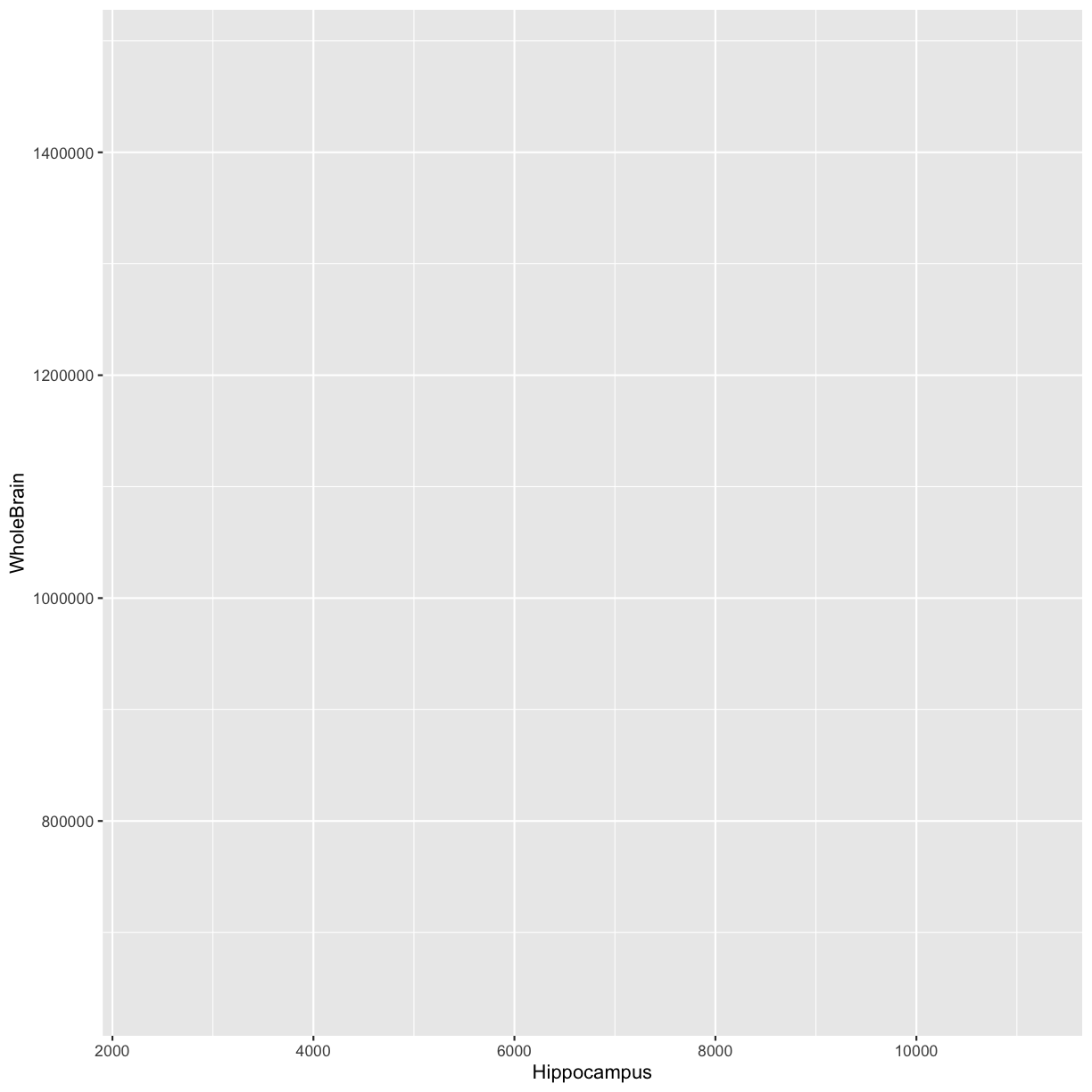
Now that we have specified what to plot on each axis, ggplot can draw the axes, but doesn’t know how to plot the data values. Note that the scales already correspond to the range of the data.
Draw the data:
add ‘geoms’ for a graphical representations of the data in the plot (points,
lines, bars). ggplot2 offers many different geoms; we will use some
common ones today, including:
* `geom_point()` for scatter plots, dot plots, etc.
* `geom_boxplot()` for, well, boxplots!
* `geom_line()` for trend lines, time series, etc.
To add a geom to the plot use the + operator. Because we have two continuous variables,
let’s use geom_point() first:
ggplot(data = adni_c,
mapping = aes(x = Hippocampus,
y = WholeBrain)) +
geom_point()
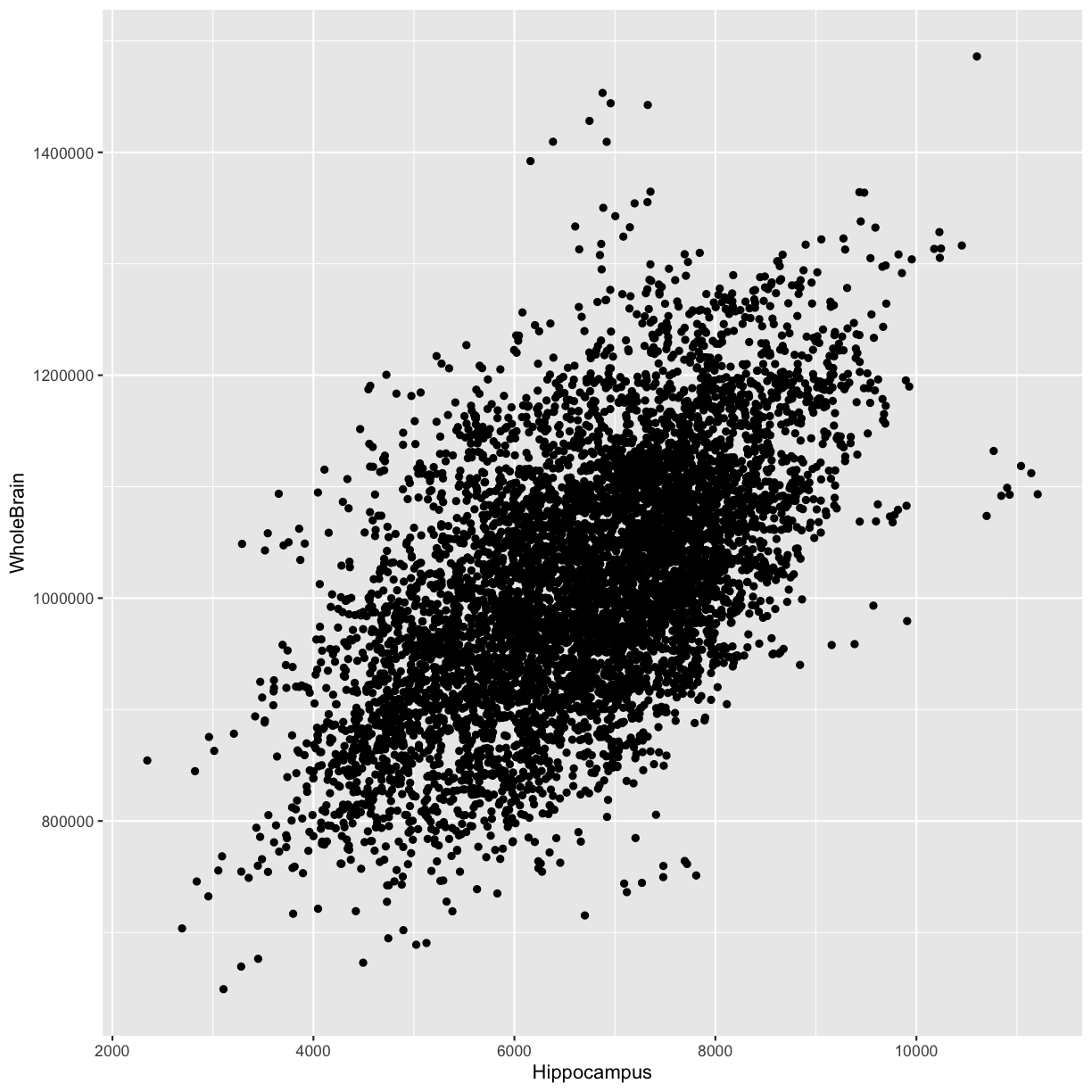
Now we have a scatterplot!
The + operator
The + in the ggplot2 package is particularly useful because it allows you
to modify existing ggplot objects. This means you can easily set up plot
templates and conveniently explore different types of plots, so the above
plot can also be generated with code like this:
# Assign plot to a variable
adni_plot <- ggplot(data = adni_c,
aes(x = Hippocampus,
y = WholeBrain))
# Draw the plot
adni_plot +
geom_point()
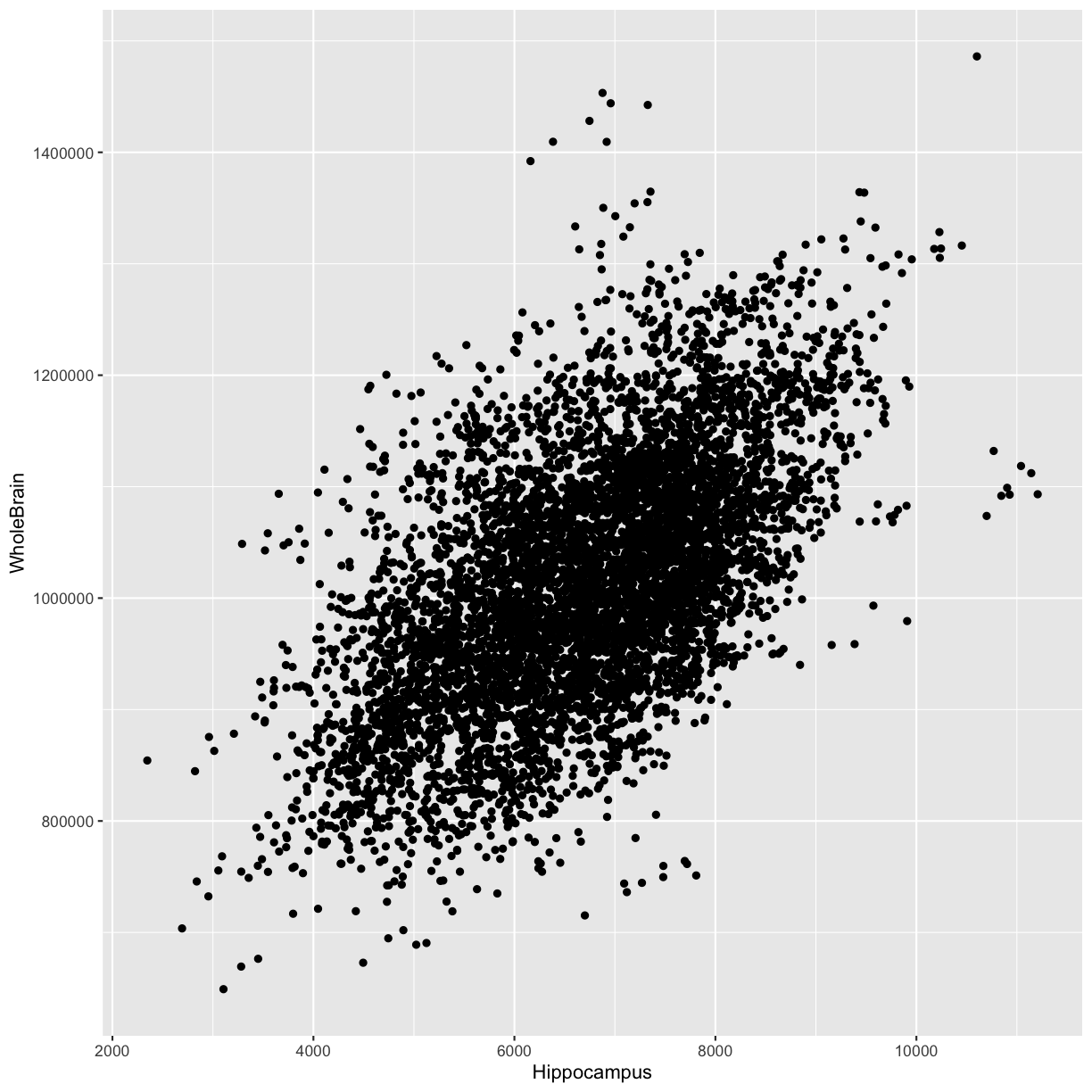 Notes
Notes
- Anything you put in the
ggplot()function can be seen by any geom layers that you add (i.e., these are universal plot settings). This includes the x- and y-axis mapping you set up inaes(). - You can also specify mappings for a given geom independently of the
mappings defined globally in the
ggplot()function. - The
+sign used to add new layers must be placed at the end of the line containing the previous layer. If, instead, the+sign is added at the beginning of the line containing the new layer,ggplot2will not add the new layer and will return an error message.
# This is the correct syntax for adding layers
adni_plot +
geom_point()
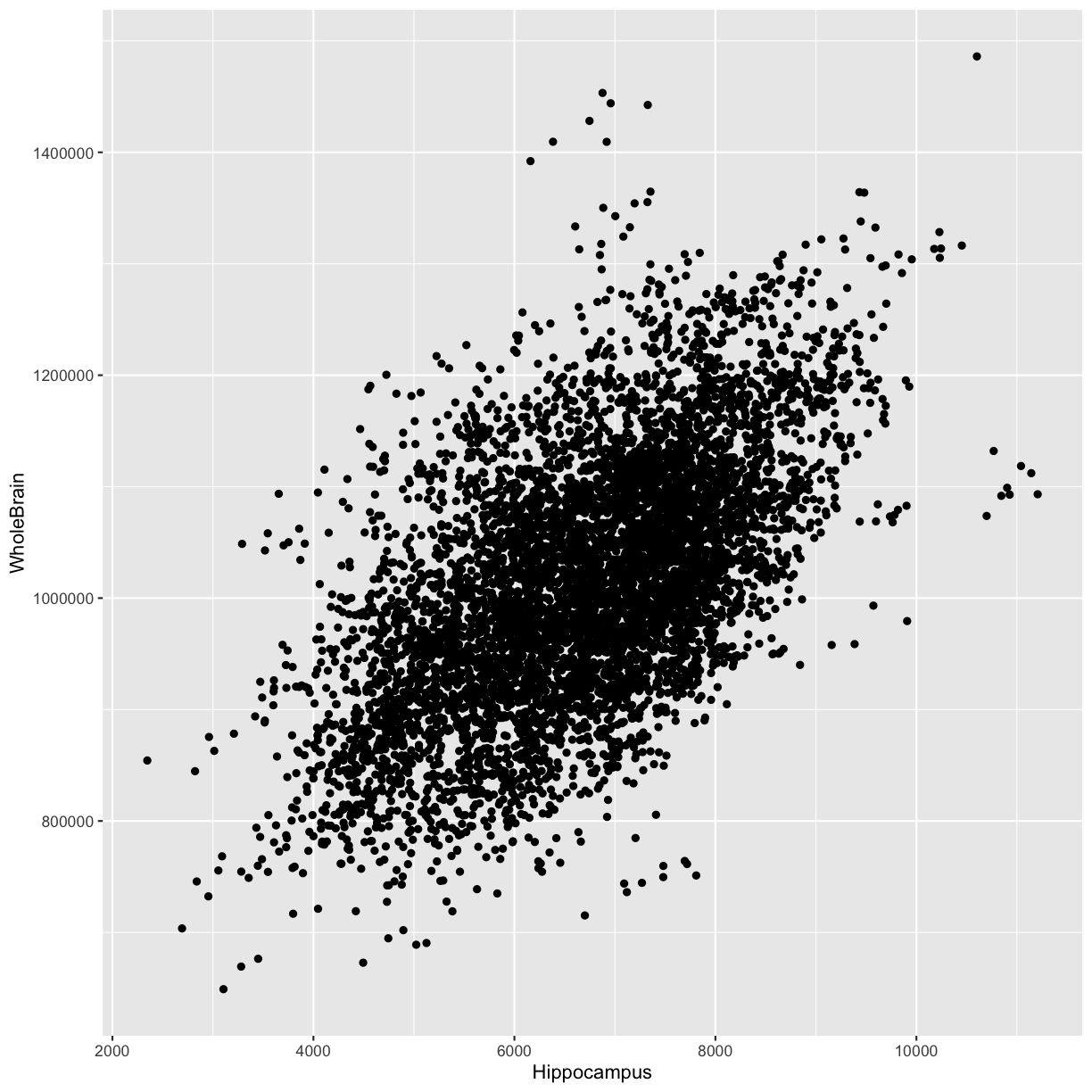
# This will not add the new layer and will return an error message
adni_plot
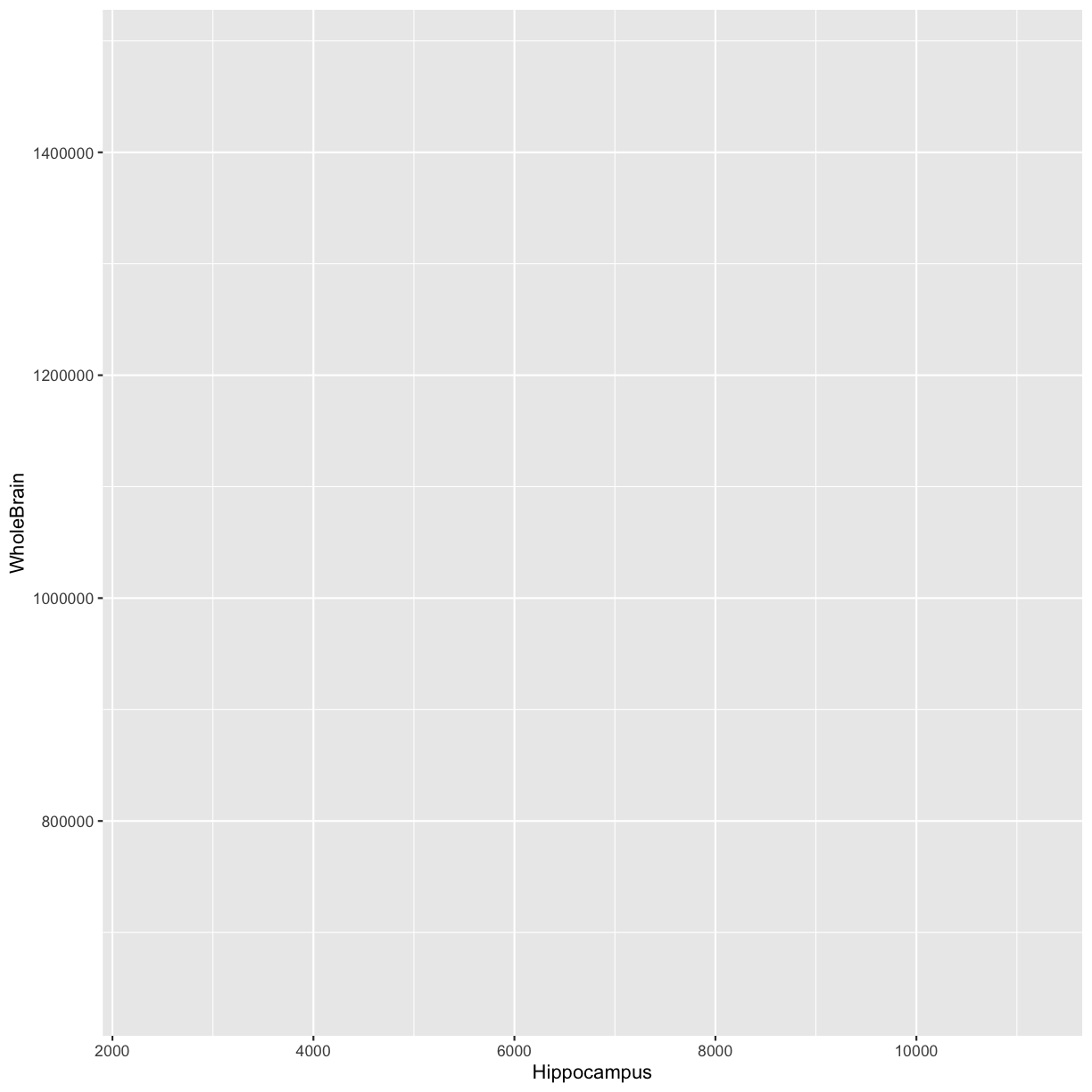
+ geom_point()
Error: Cannot use `+.gg()` with a single argument. Did you accidentally put + on a new line?
Challenge 1
Scatter plots can be useful exploratory tools for small datasets. For data sets with large numbers of observations, such as the
adni_cdata set, overplotting of points can be a limitation of scatter plots. One strategy for handling such settings is to use hexagonal binning of observations. The plot space is tessellated into hexagons. Each hexagon is assigned a color based on the number of observations that fall within its boundaries. To use hexagonal binning withggplot2, first install the R packagehexbinfrom CRAN:install.packages("hexbin") library(hexbin)Then use the
geom_hex()function:adni_plot + geom_hex()
What are the relative strengths and weaknesses of a hexagonal bin plot compared to a scatter plot? Examine the above scatter plot and compare it with the hexagonal bin plot that you created.
Solution
It looks nicer, but its not as granular
Building your plots iteratively
Building plots with ggplot2 is typically an iterative process. We start by
defining the dataset we’ll use, lay out the axes, and choose a geom:
ggplot(data = adni_c,
mapping = aes(x = Hippocampus,
y = WholeBrain)) +
geom_point()
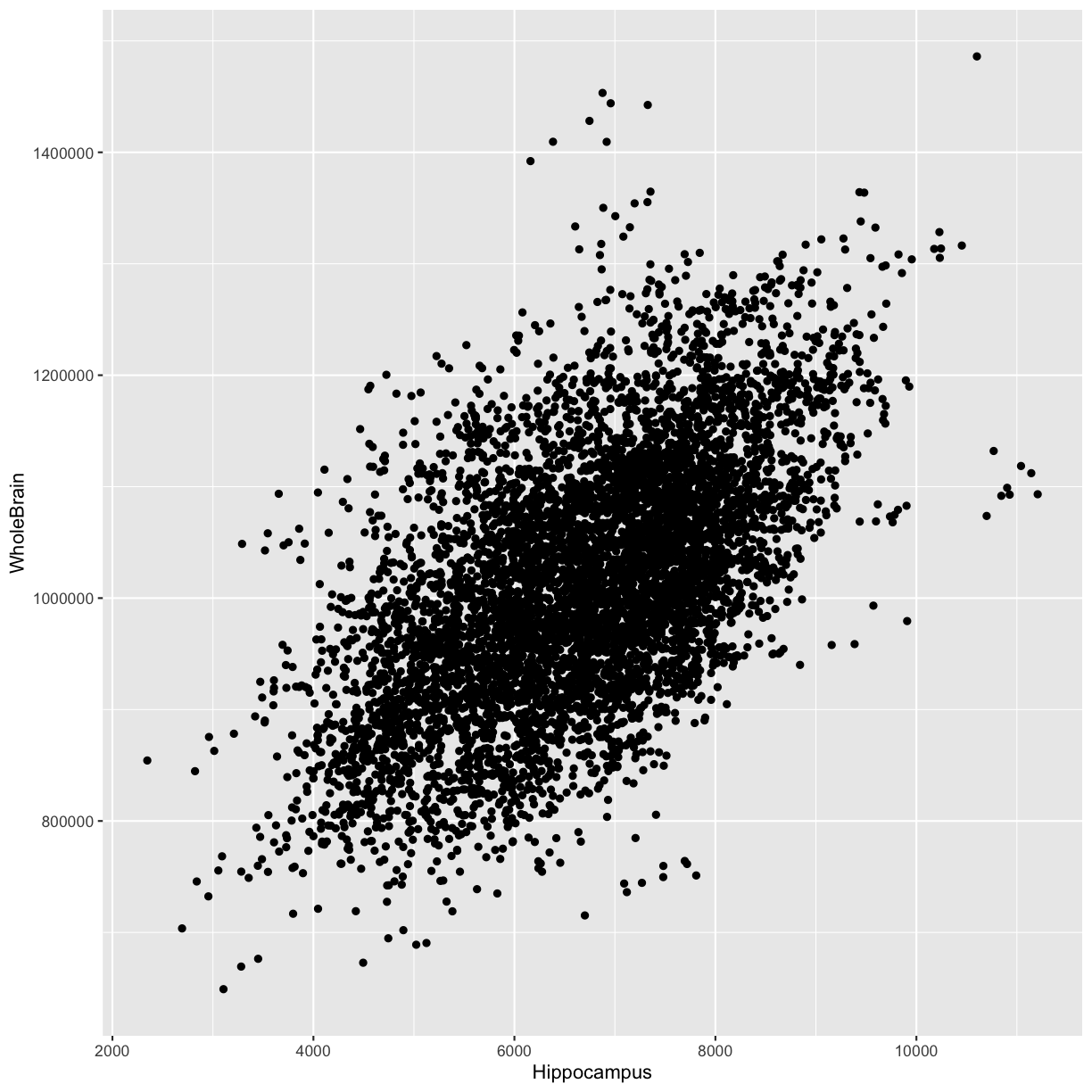
Then, we start modifying this plot to extract more information from it. For
instance, we can add transparency (alpha) to avoid overplotting:
ggplot(data = adni_c,
mapping = aes(x = Hippocampus,
y = WholeBrain)) +
geom_point(alpha = 0.1)
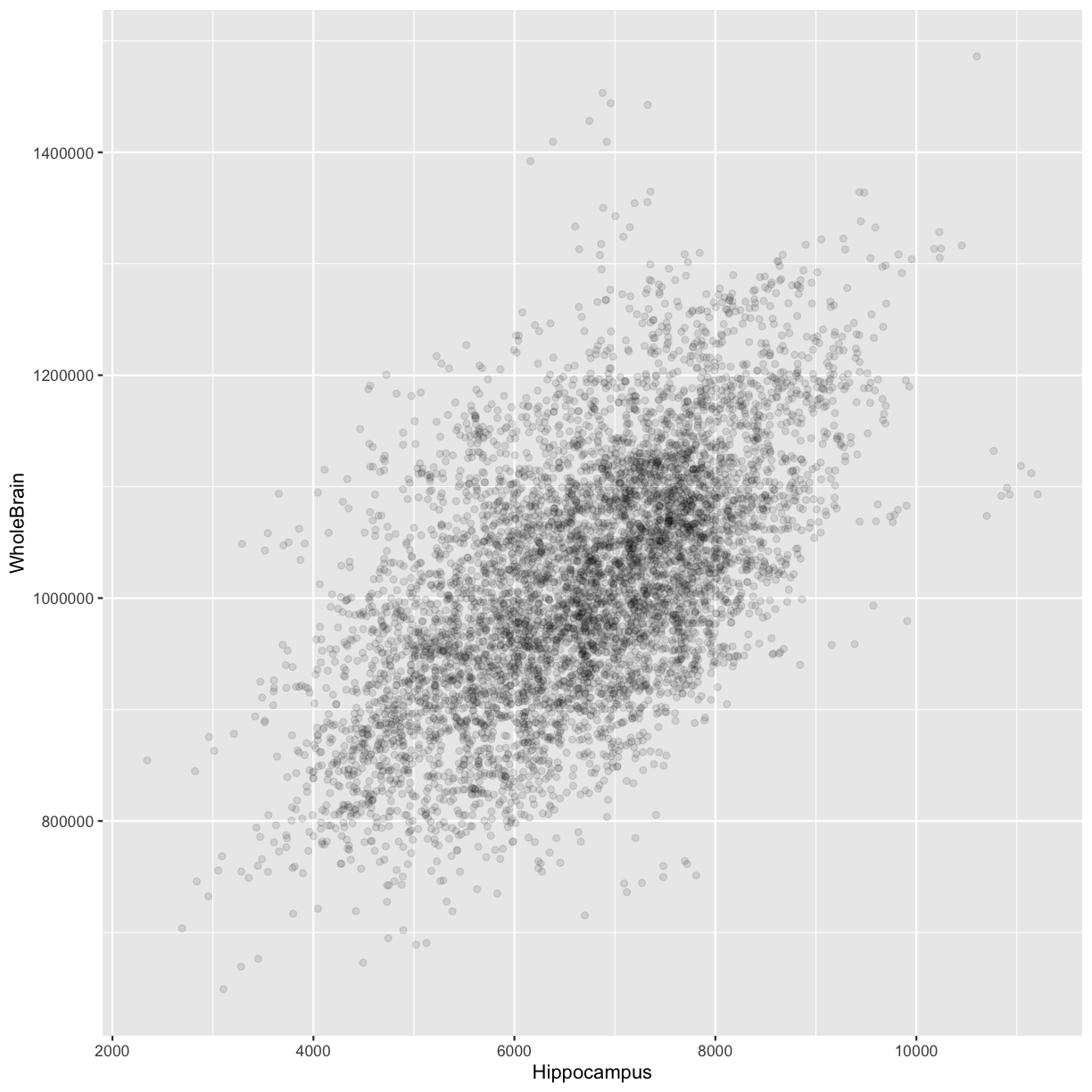
We can also add colors for all the points:
ggplot(data = adni_c,
mapping = aes(x = Hippocampus,
y = WholeBrain)) +
geom_point(alpha = 0.1,
color = "blue")
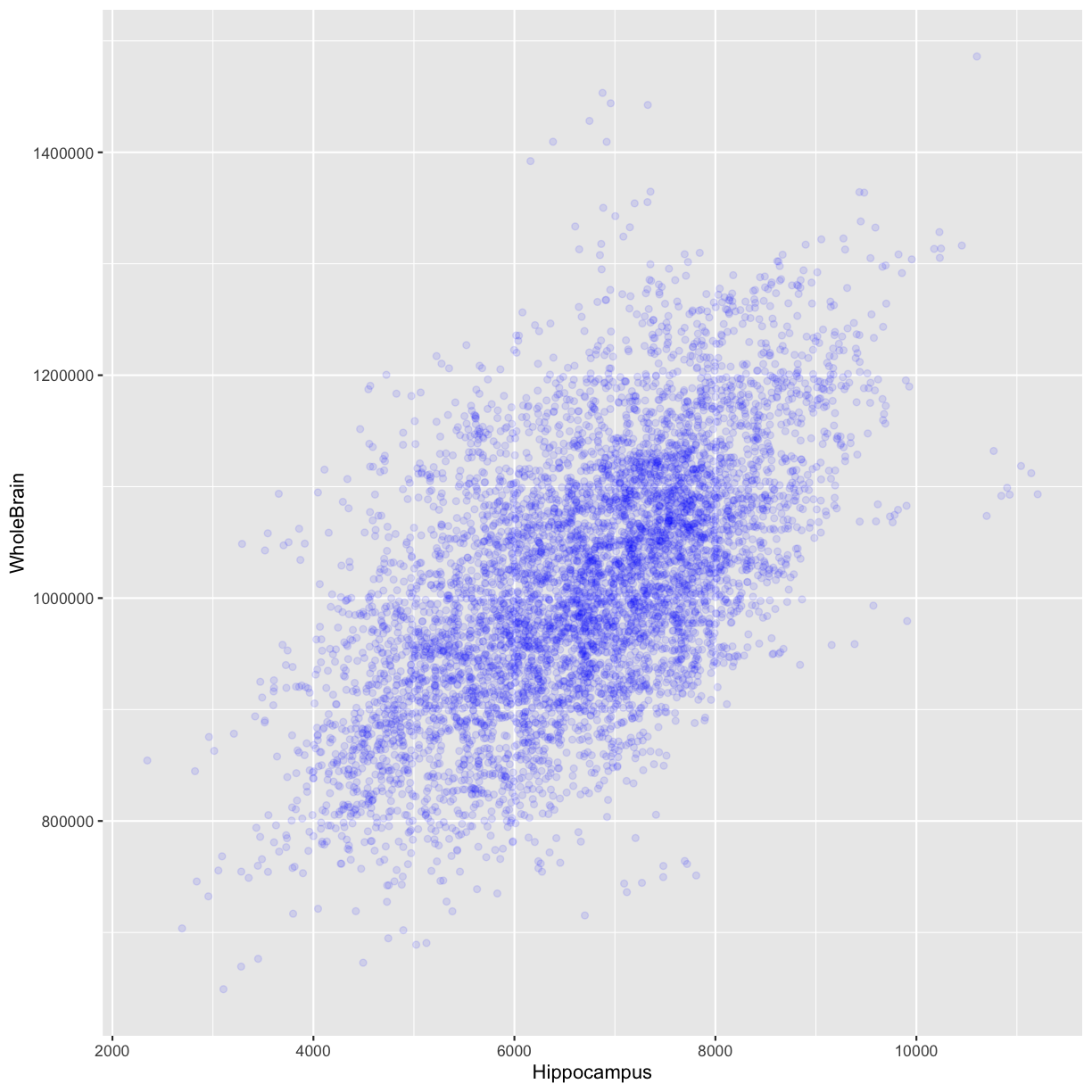
Or to color each of the patient’s gender in the plot differently, you could use a vector as an input to the argument color. ggplot2 will provide a different color corresponding to different values in the vector. Here is an example where we color with PTGENDER:
ggplot(data = adni_c,
mapping = aes(x = Hippocampus,
y = WholeBrain)) +
geom_point(alpha = 0.5,
aes(color = PTGENDER))
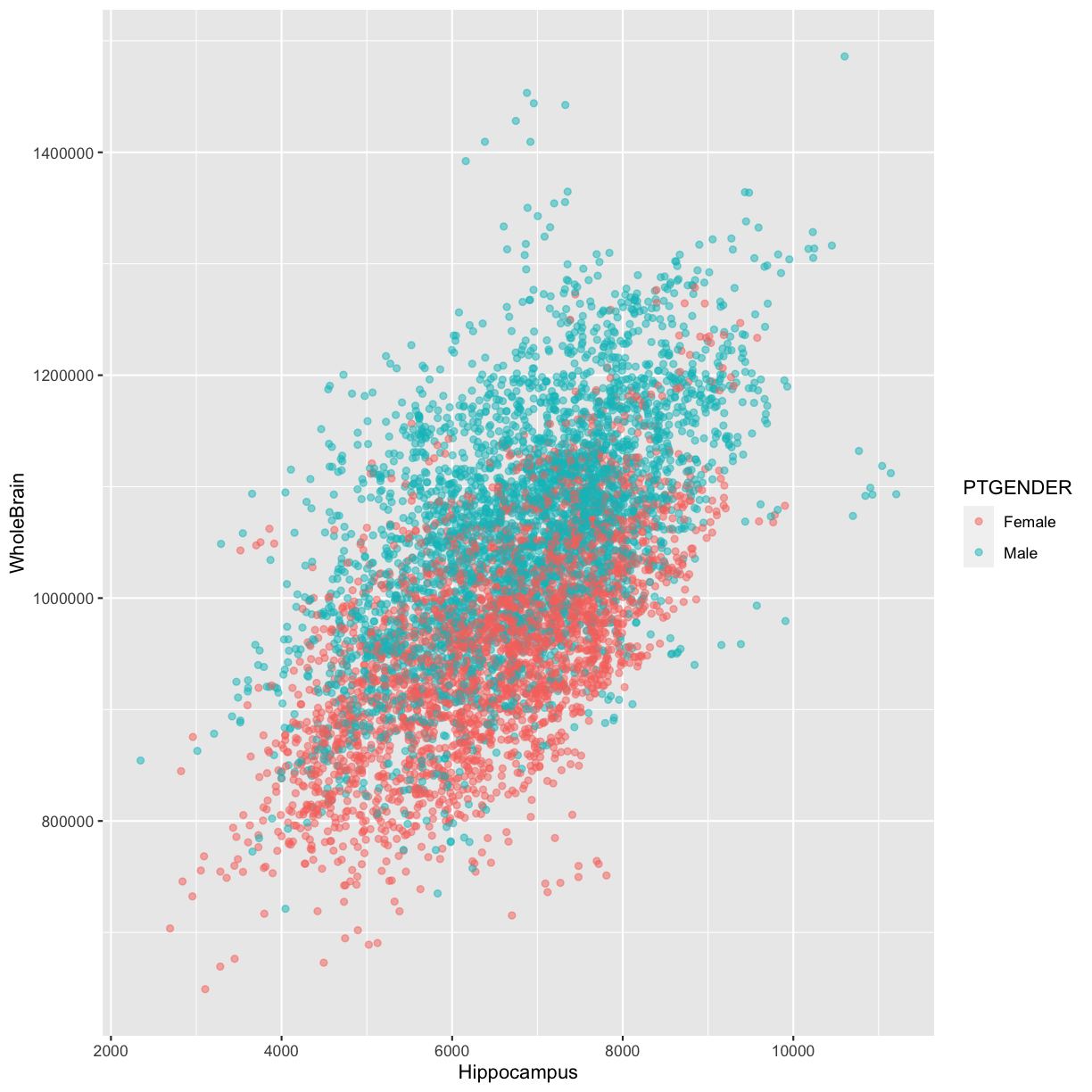
Challenge 2
Modify the following code to create a scatter plot that colors the points by values in the APOE column.
ggplot(data = adni_c, mapping = aes(x = Hippocampus, y = WholeBrain, color = PTGENDER)) + geom_point(alpha = 0.5)
Did you get what you expected?
Solution
ggplot(data = adni_c, mapping = aes(x = Hippocampus, y = WholeBrain, color = APOE4)) + geom_point(alpha = 0.5)
APOE is a numeric column, so it maps the color as a gradient. If you want each condition to be a different color, convert it to factor
ggplot(data = adni_c, mapping = aes(x = Hippocampus, y = WholeBrain, color = as.factor(APOE4))) + geom_point(alpha = 0.5)
Boxplot
We can use boxplots to visualize the distribution of whole brain volume within each gender:
ggplot(data = adni_c,
mapping = aes(x = PTGENDER,
y = WholeBrain)) +
geom_boxplot()
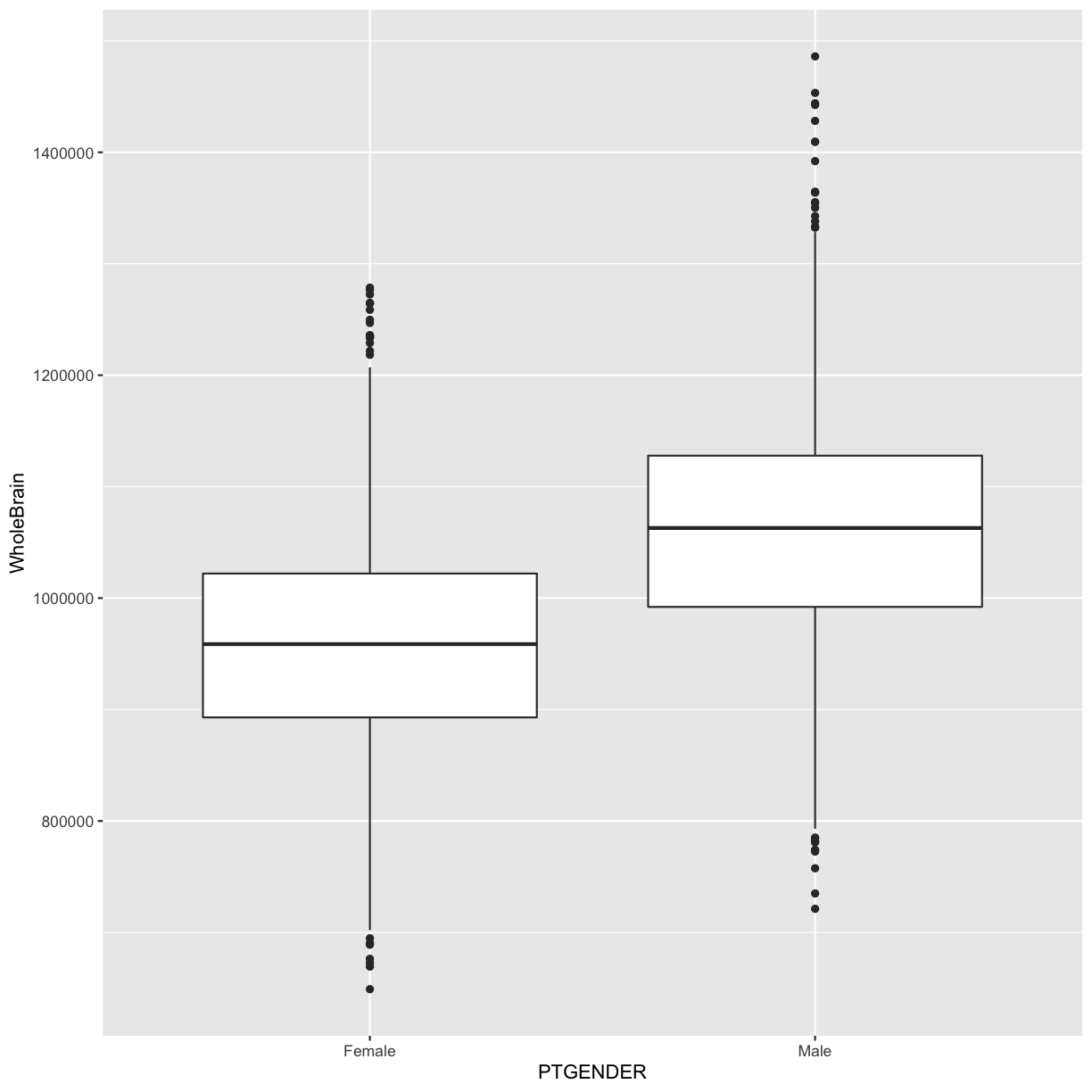
By adding points to boxplot, we can have a better idea of the number of measurements and of their distribution:
ggplot(data = adni_c,
mapping = aes(x = PTGENDER,
y = WholeBrain)) +
geom_boxplot()+
geom_jitter(color = "tomato")
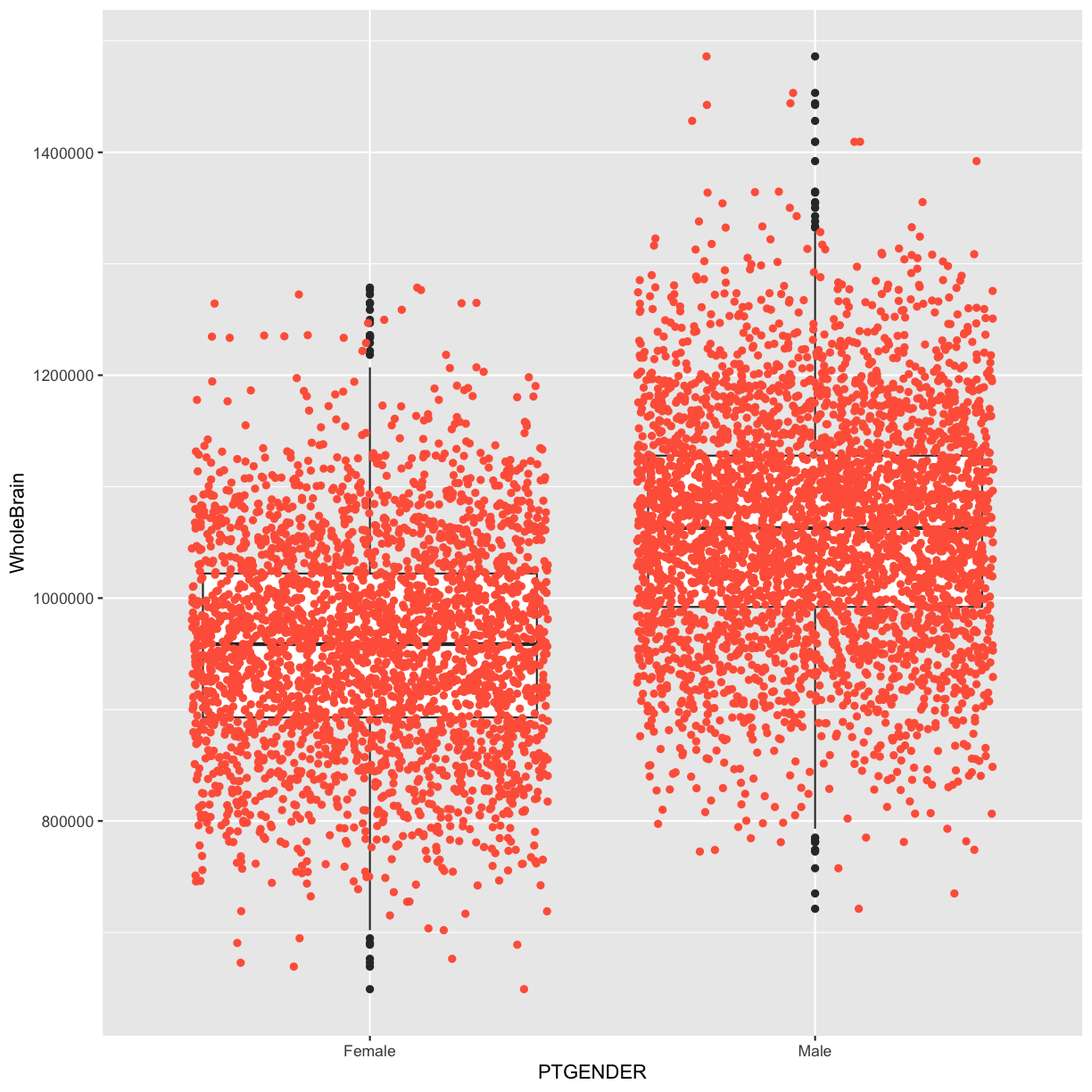
Notice how the boxplot layer is behind the jitter layer? What do you need to change in the code to put the boxplot in front of the points such that it’s not hidden?
Challenge
Notice how the boxplot layer is behind the jitter layer in the previous plot? What do you need to change in the code to put the boxplot in front of the points such that it’s not hidden?
Solution
ggplot(data = adni_c, mapping = aes(x = PTGENDER, y = WholeBrain)) + geom_jitter(color = “tomato”) + geom_boxplot() ```
Colors and multiple geoms
We can specify how to color the points on the plot in two places:
- In the
geom_XX()function, as we’ve seen in the above examples. This option only affects the geom that you put the color argument in. - In the
ggplot()function. Parameters specified in ggplot will affect the entire plot.
ALL geom layers and the mapping will be determined by the x- and y-axis set up in aes(). Let’s see an example.
The following plot colors the jittered dots by PTGENDER. The boxes remain black and white.
ggplot(data = adni_c,
mapping = aes(x = PTGENDER,
y = WholeBrain)) +
geom_jitter(aes(color = PTGENDER))+
geom_boxplot()
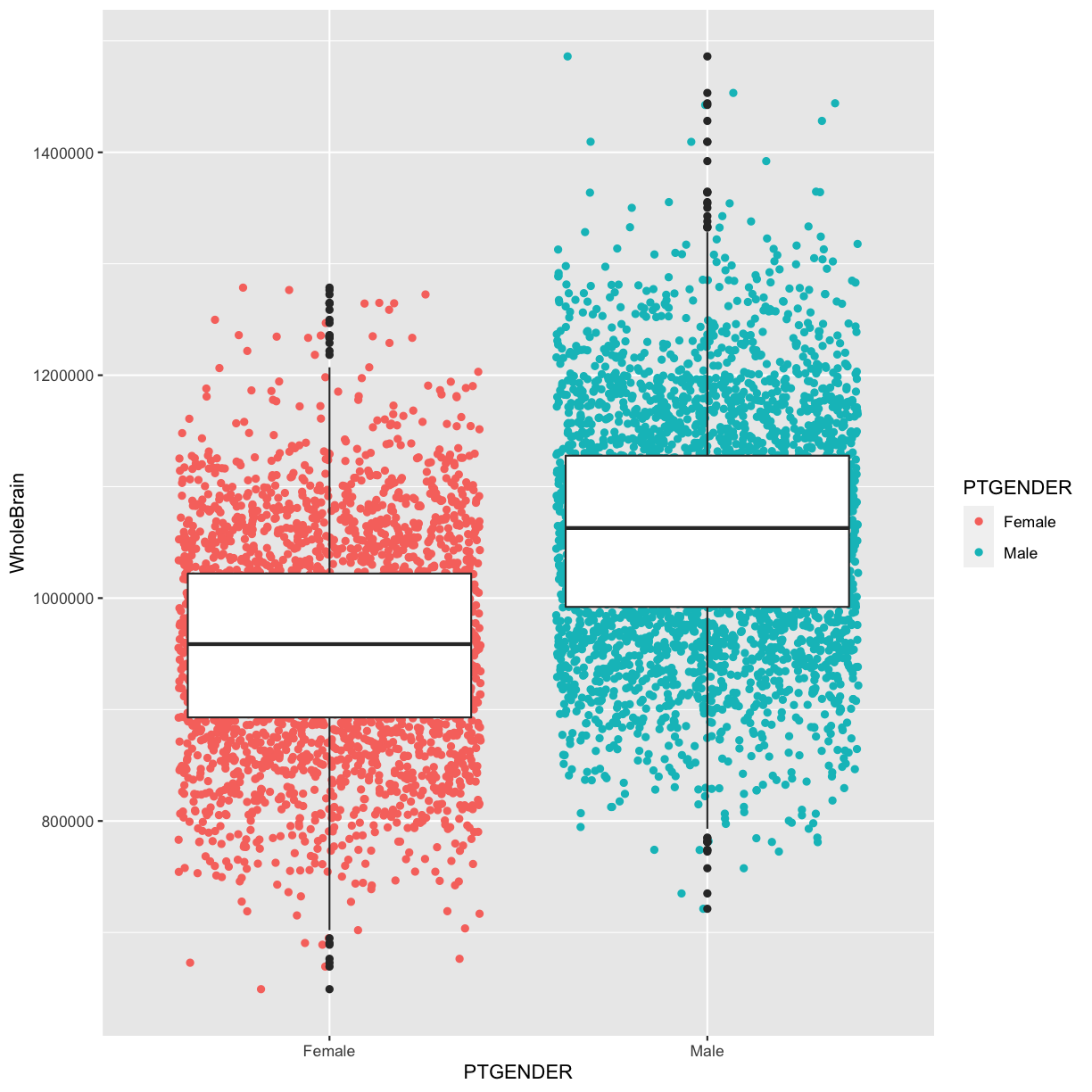
Now let’s see what the plot looks like when we move the color argument to the ggplot function.
ggplot(data = adni_c,
mapping = aes(x = PTGENDER,
y = WholeBrain,
color = PTGENDER)) +
geom_jitter()+
geom_boxplot()
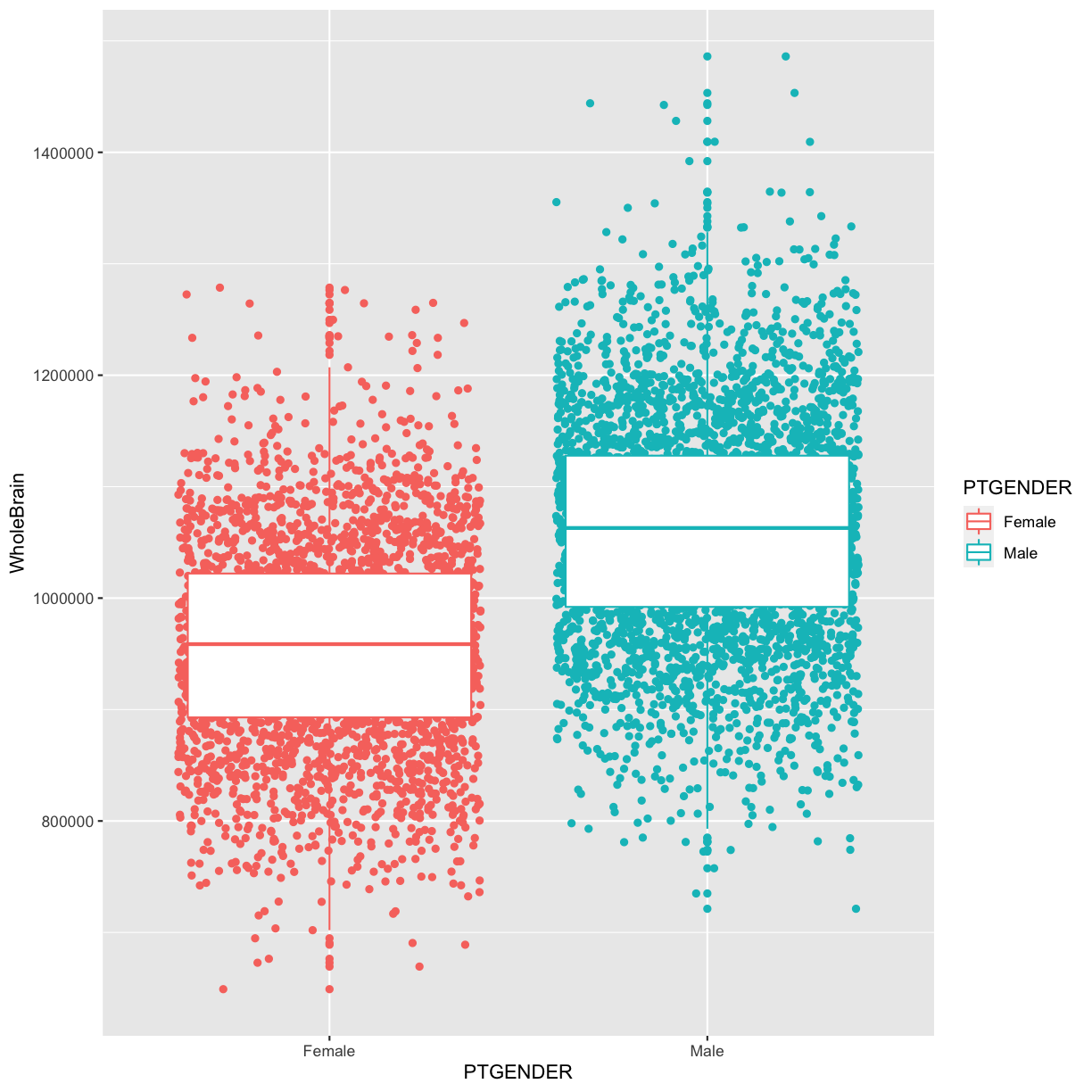
Now the box outlines are also colored by PTGENDER and the lines blend into the jitter.
Notice that we can change the geom layer and colors will be still determined by PTGENDER
ggplot(data = adni_c,
mapping = aes(x = PTGENDER,
y = WholeBrain,
color = PTGENDER)) +
geom_boxplot()+
geom_point()
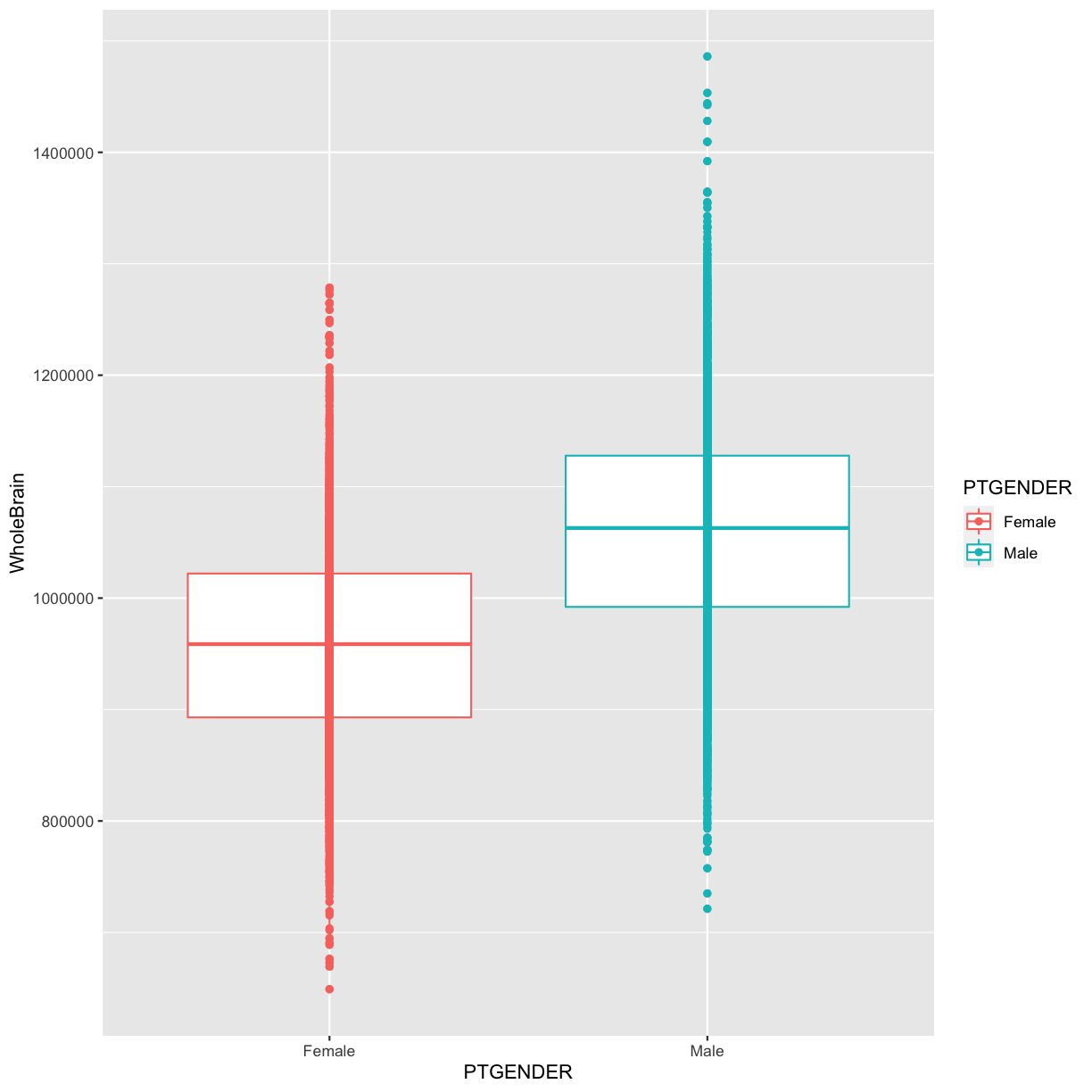
Plotting time series data
Let’s calculate the mean whole brain volume by age for each APOE4 status group. First we need
to group the data and count records within each group. However, we need to reshape the data first using what we learned with dplyr, We need a data frame with a row for each APOE4 AGE combination, and columns for the mean (mean_hippocampus) and standard deviation (sd_hippocampus) of hippocampus volume.
| APOE4 | AGE | mean_hippocampus | sd_hippocampus |
|---|---|---|---|
| 0 | 70 | … | … |
| 1 | 70 | … | … |
| 2 | 70 | … | … |
| 0 | 71 | … | … |
| 1 | 71 | … | … |
| 2 | 71 | … | … |
adni_time <- adni_c%>%
group_by(APOE4, AGE)%>%
summarize(mean_hippocampus = mean(Hippocampus),
sd_hippocampus = sd(Hippocampus))
adni_time
# A tibble: 103 x 4
# Groups: APOE4 [3]
APOE4 AGE mean_hippocampus sd_hippocampus
<dbl> <dbl> <dbl> <dbl>
1 0 54 8004 NA
2 0 55 5925. 352.
3 0 56 7211. 1049.
4 0 57 6713. 1589.
5 0 58 7493. 918.
6 0 59 8141 1406.
7 0 60 8260. 825.
8 0 61 8286. 921.
9 0 62 7730. 1512.
10 0 63 7701. 681.
# … with 93 more rows
Time series data can be visualized as a line plot with age on the x axis and mean Hippocampus volume on the y axis:
ggplot(data = adni_time,
mapping = aes(x = AGE,
y = mean_hippocampus)) +
geom_line()
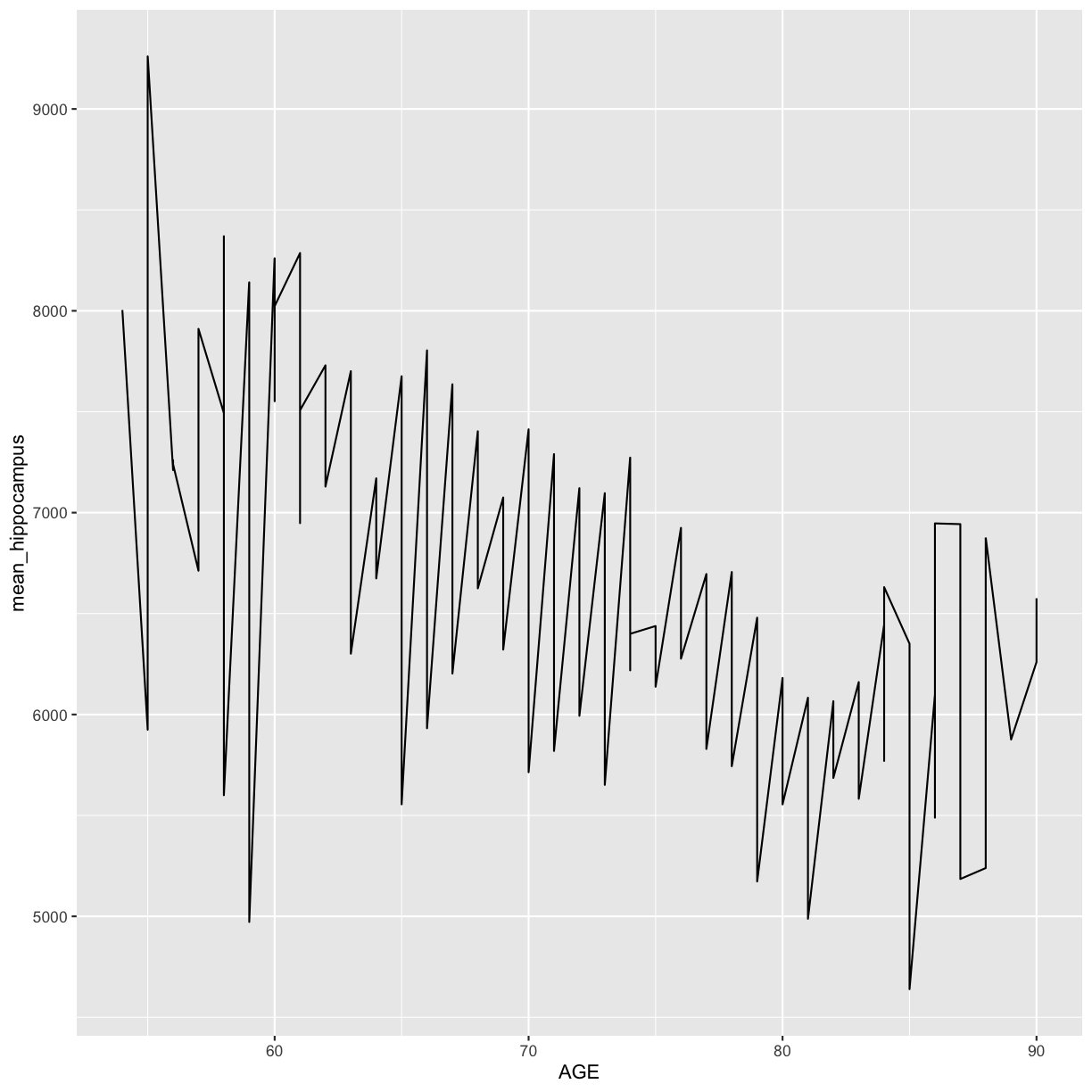
Unfortunately, this does not work because we plotted data for all three APOE4 categories together. We need to tell ggplot to draw a line for each APOE4 by modifying
the aesthetic function to include group = APOE4:
ggplot(data = adni_time,
mapping = aes(x = AGE,
y = mean_hippocampus,
group = APOE4)) +
geom_line()
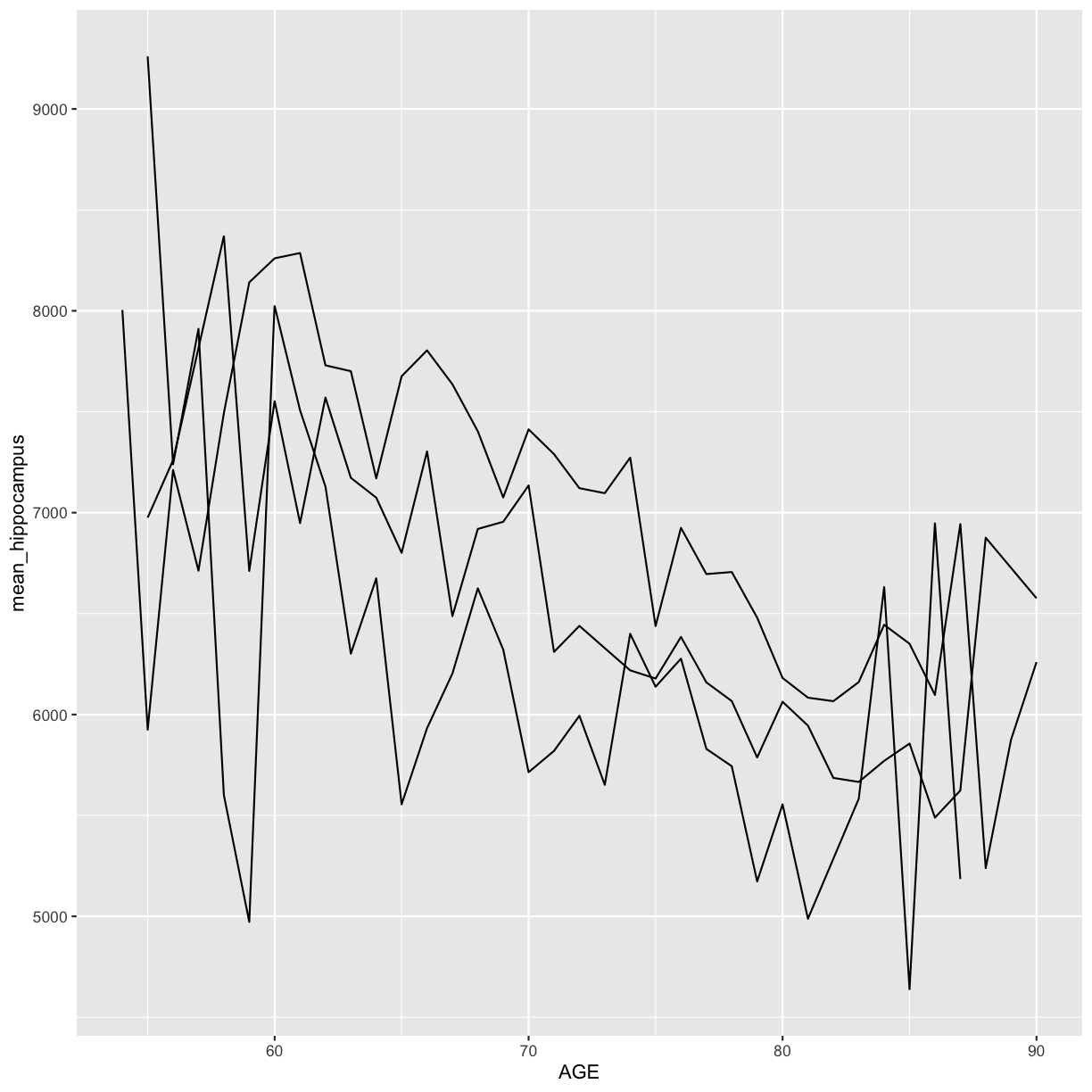
We will be able to distinguish APOE4 groups in the plot if we add colors (using color also automatically groups the data). Note that we’re using both group and color here.
ggplot(data = adni_time,
mapping = aes(x = AGE,
y = mean_hippocampus,
group = APOE4,
color = as.factor(APOE4))) +
geom_line()
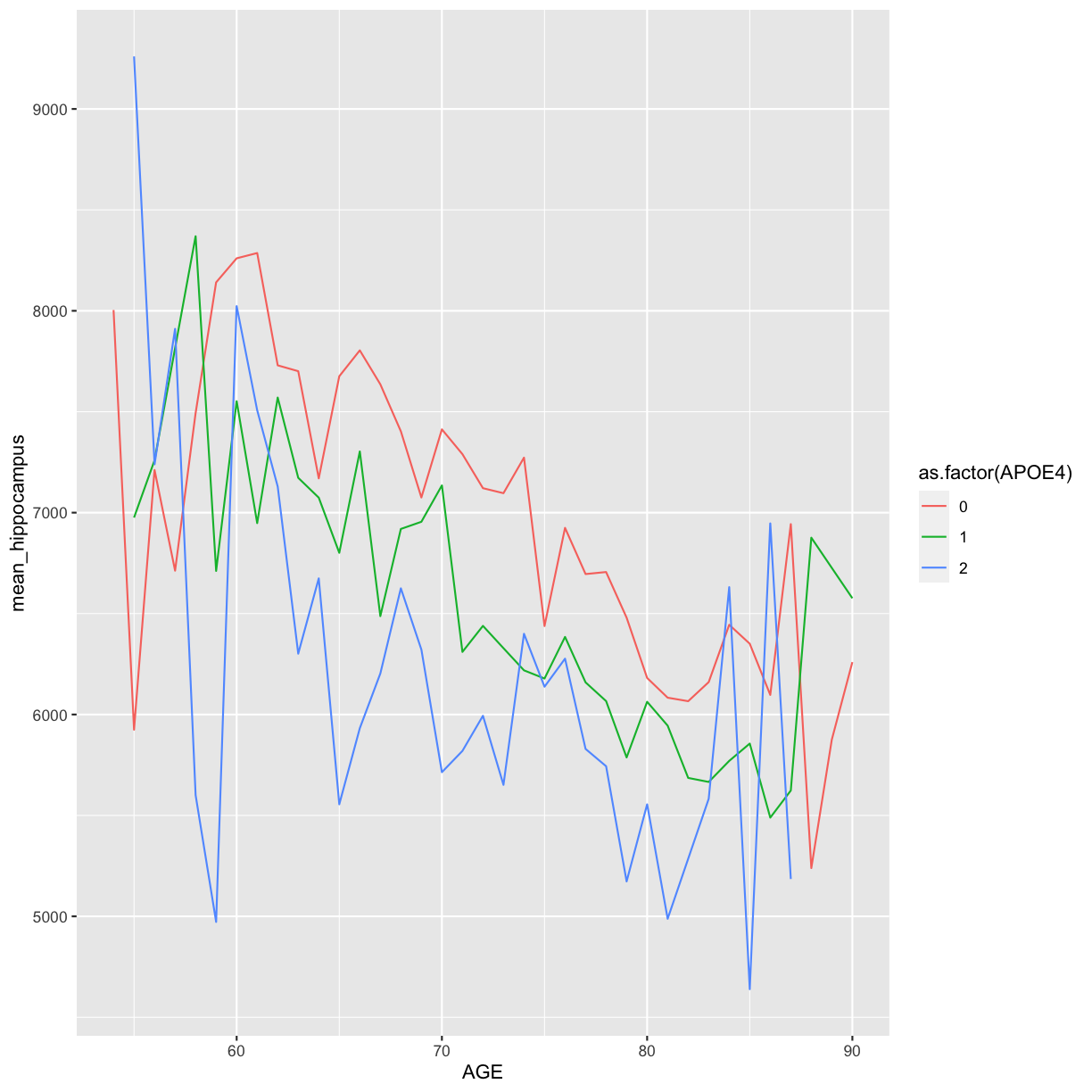
In reality, you only need color and it looks the same
ggplot(data = adni_time,
mapping = aes(x = AGE,
y = mean_hippocampus,
color = as.factor(APOE4))) +
geom_line()
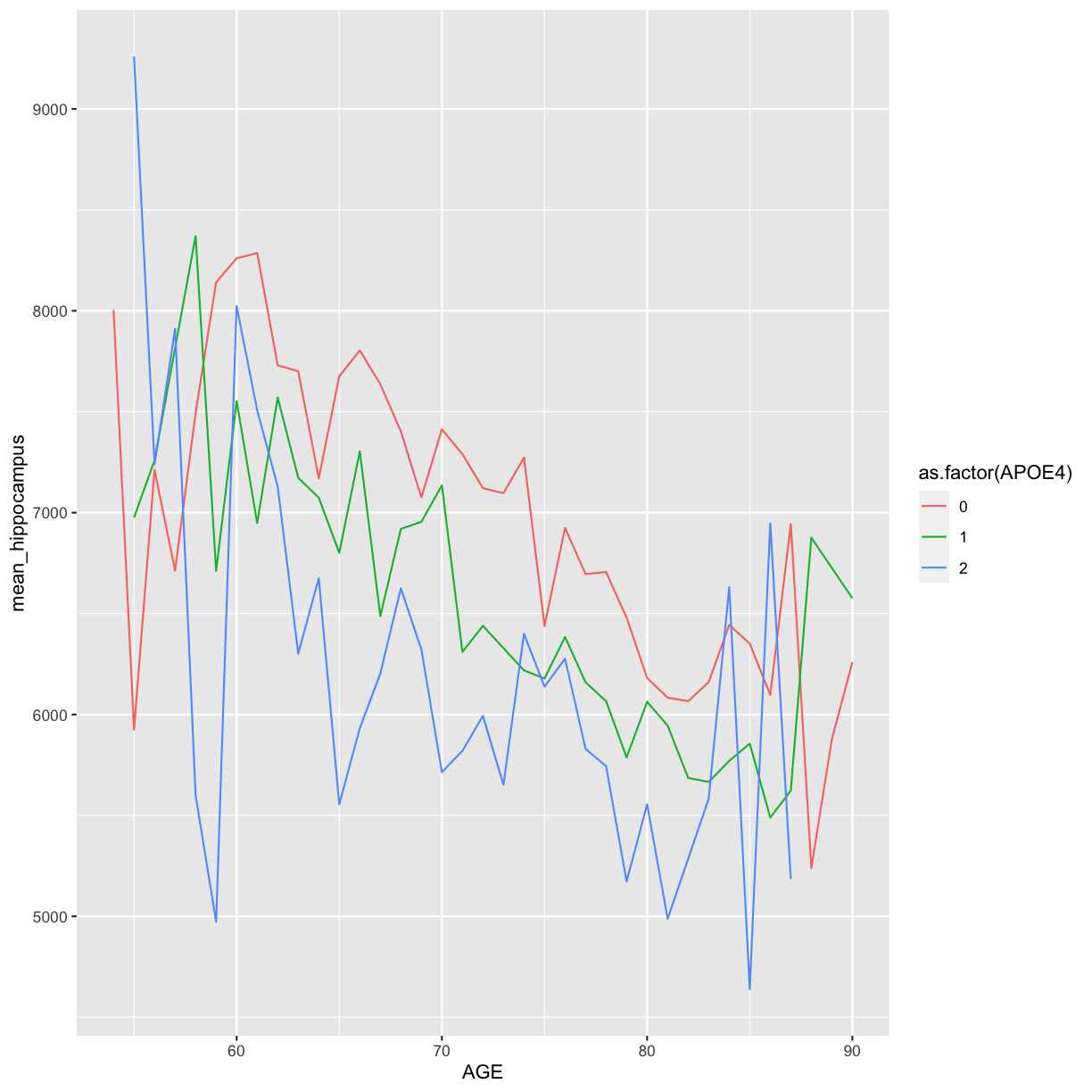 However, occasionally using color alone won’t work. If this happens to you, try adding group back and see if it helps.
However, occasionally using color alone won’t work. If this happens to you, try adding group back and see if it helps.
It looks like there might be a relationship between APOE allele number and hippocampus volume by age. Let’s see what the variation in the dat looks like by adding error bars.
Adding error bars
ggplot(data = adni_time,
mapping = aes(x = AGE,
y = mean_hippocampus,
#group = APOE4,
color = as.factor(APOE4))) +
geom_line()+
geom_errorbar(aes(ymin = mean_hippocampus-sd_hippocampus,
ymax = mean_hippocampus+sd_hippocampus))
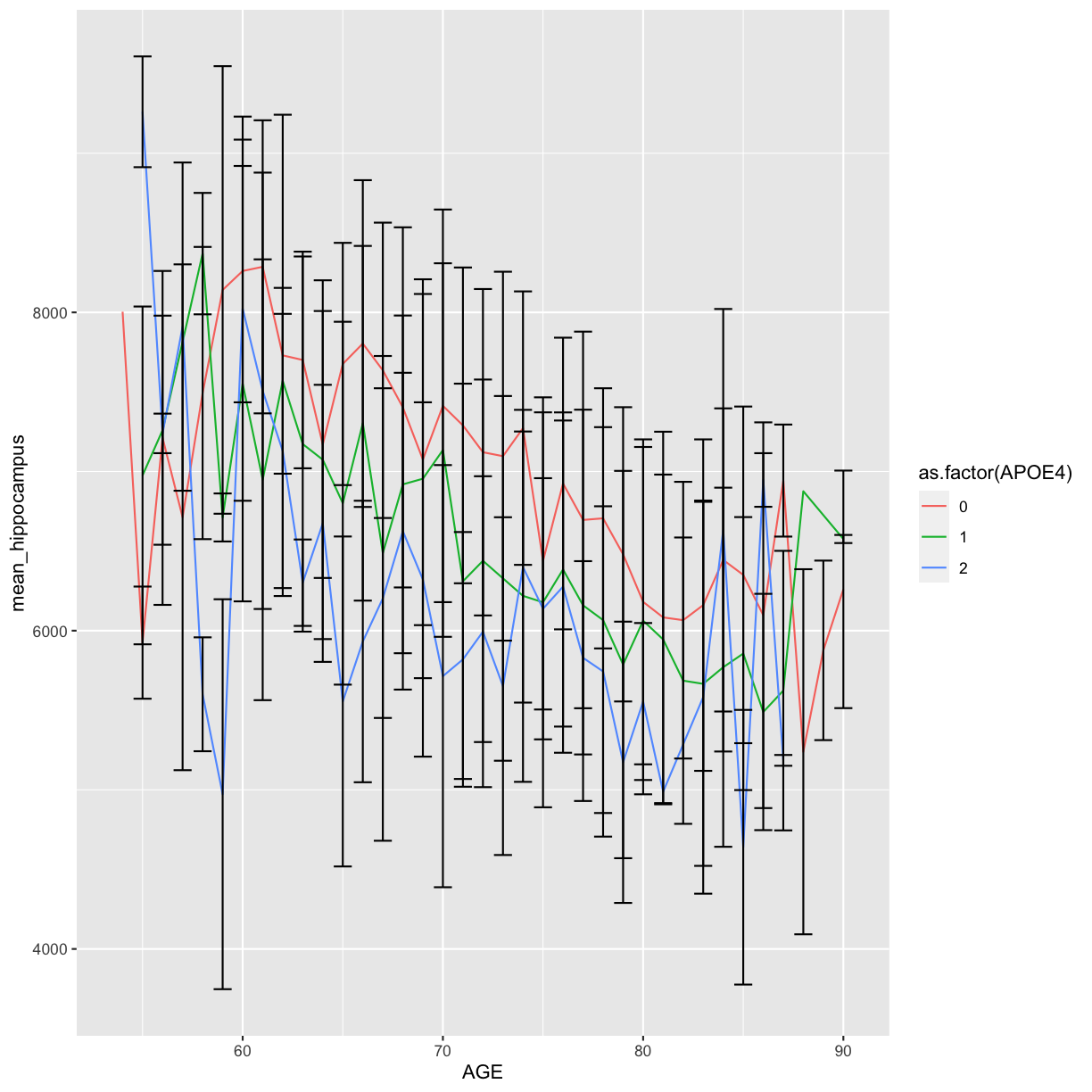
Unfortunately, the variation is larger than the effect from the look of it, so the relationship is weak.
Faceting
ggplot2 has a special technique called faceting that allows the user to split one
plot into multiple plots based on a variable/feature included in the dataset. We will use it to
make a time series plot for each APOE4 group:
ggplot(data = adni_time,
mapping = aes(x = AGE,
y = mean_hippocampus)) +
geom_line() +
facet_wrap(~ APOE4)
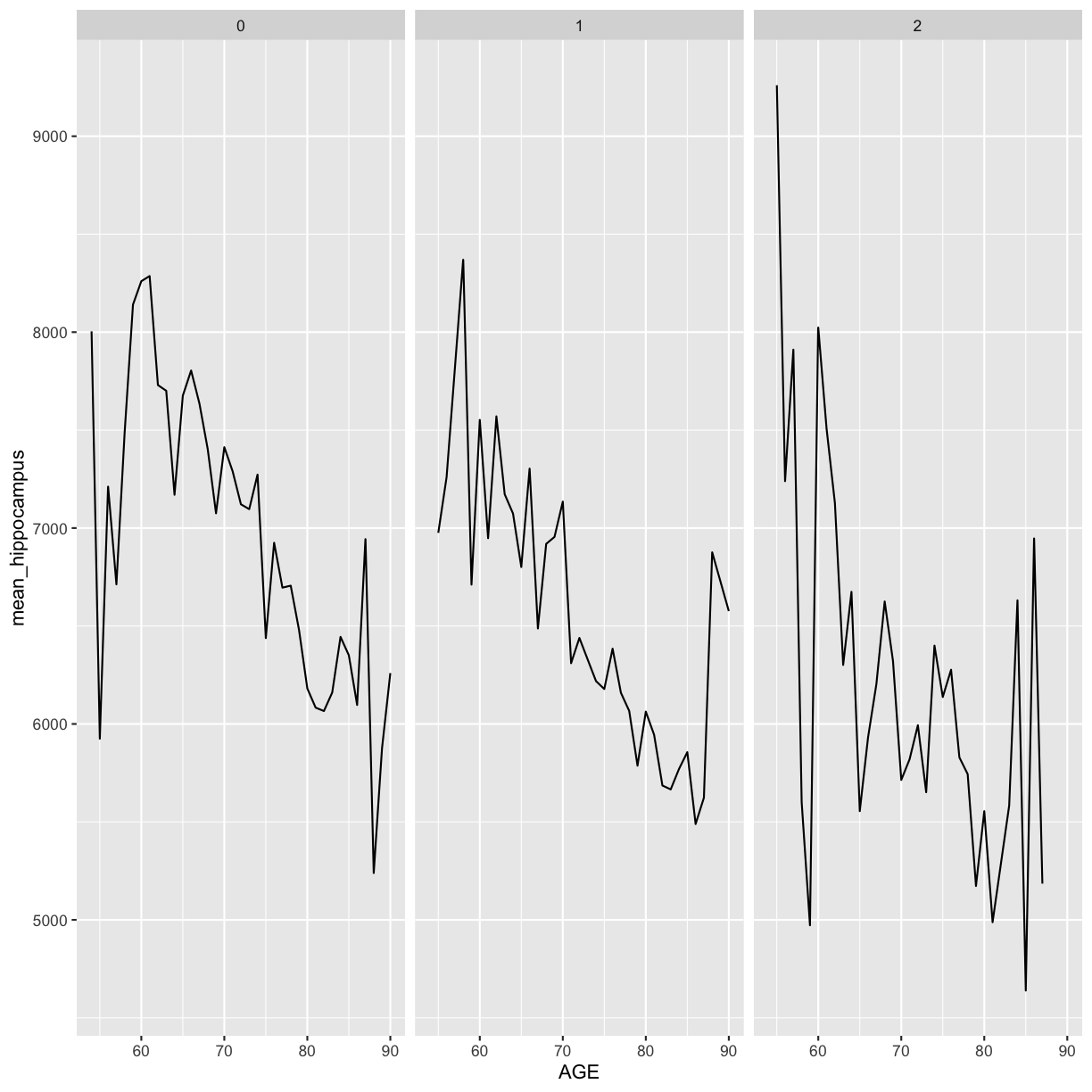
What if we want to look at the effect of PTGENDER in each APOE4 group? We need to add another variable to the adni_time data frame: PTGENDER.
adni_time <- adni_c%>%
group_by(APOE4, AGE, PTGENDER)%>%
summarize(mean_hippocampus = mean(Hippocampus),
sd_hippocampus = sd(Hippocampus))
adni_time
# A tibble: 187 x 5
# Groups: APOE4, AGE [103]
APOE4 AGE PTGENDER mean_hippocampus sd_hippocampus
<dbl> <dbl> <chr> <dbl> <dbl>
1 0 54 Male 8004 NA
2 0 55 Female 5925. 352.
3 0 56 Female 6340 471.
4 0 56 Male 7833. 890.
5 0 57 Female 5748. 1245.
6 0 57 Male 8256. 155.
7 0 58 Female 7447. 269.
8 0 58 Male 7518. 1134.
9 0 59 Female 6917. 289.
10 0 59 Male 8928. 1261.
# … with 177 more rows
We can now make the faceted plot by splitting further by PTGENDER using color (within a single plot).
ggplot(data = adni_time,
mapping = aes(x = AGE,
y = mean_hippocampus,
color = PTGENDER)) +
geom_line() +
facet_wrap(~ APOE4)
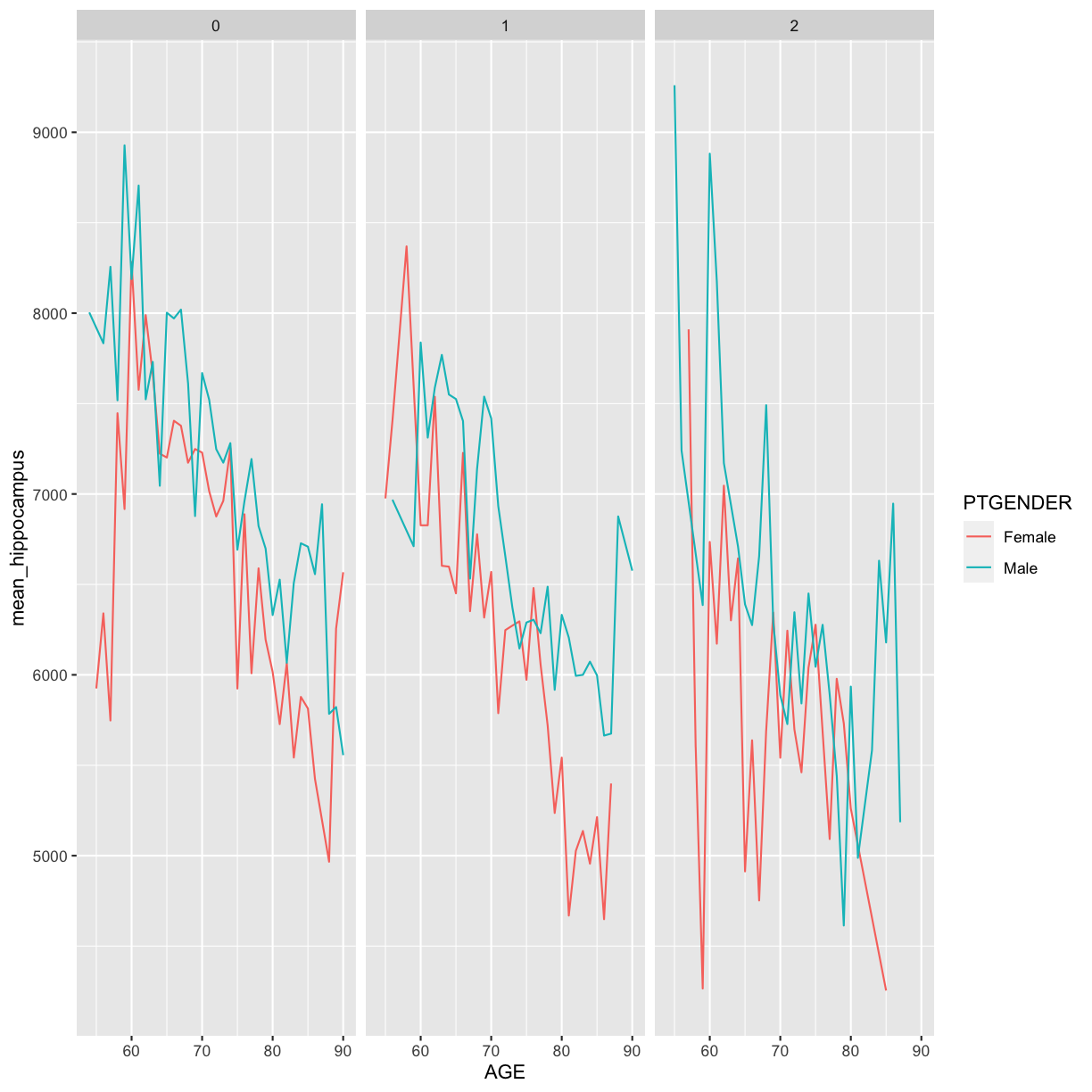
Usually plots with white background look more readable when printed. We can set
the background to white using the function theme_bw(). Additionally, you can remove
the grid:
ggplot(data = adni_time,
mapping = aes(x = AGE,
y = mean_hippocampus,
color = PTGENDER)) +
geom_line() +
facet_wrap(~ APOE4)+
theme_bw() +
theme(panel.grid = element_blank())
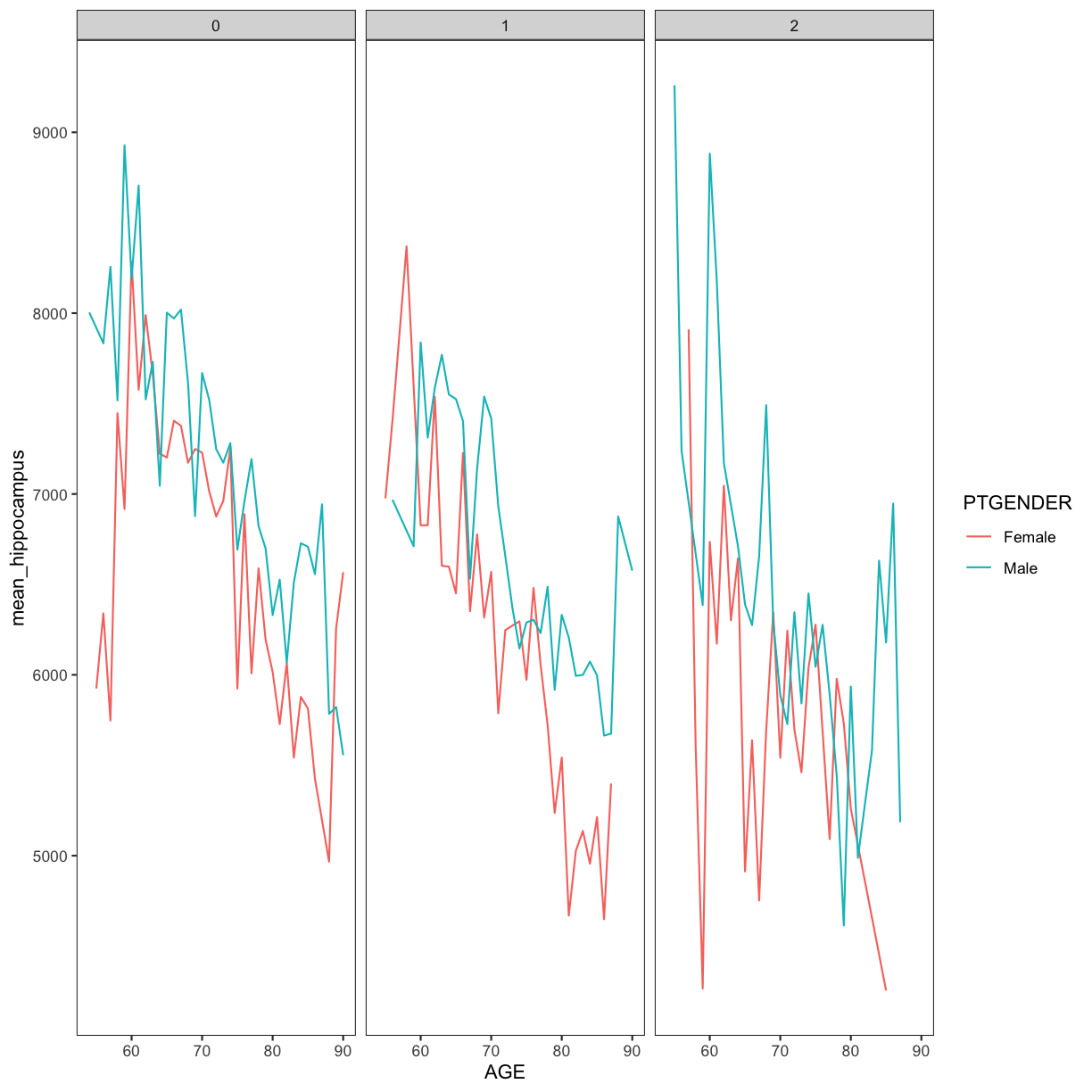
ggplot2 themes
In addition to theme_bw(), which changes the plot background to white, ggplot2
comes with several other themes which can be useful to quickly change the look
of your visualization. The complete list of themes is available
at https://ggplot2.tidyverse.org/reference/ggtheme.html. theme_minimal() and
theme_light() are popular, and theme_void() can be useful as a starting
point to create a new hand-crafted theme.
The
ggthemes package
provides a wide variety of options (including an Excel 2003 theme).
The ggplot2 extensions website provides a list
of packages that extend the capabilities of ggplot2, including additional
themes.
Challenge 3
Use what you just learned to create a plot that depicts how the average whole brain volume of each APOE4 group changes by age. Use
dplyrfunctions to create a new data.frame calledage_wholebrainthat contains a new column calledavg_wholebrainfor each APOE4 group and age. Then create a plot that shows the differences inavg_wholebrainvalues for each group at each age.Solution
age_wholebrain <- adni_c %>% group_by(AGE, APOE4) %>% summarize(avg_wholebrain = mean(WholeBrain)) ggplot(data = age_wholebrain, mapping = aes(x=AGE, y=avg_wholebrain)) + geom_line() + facet_wrap(~ APOE4) + theme_bw()
The facet_wrap geometry extracts plots into an arbitrary number of dimensions
to allow them to cleanly fit on one page. On the other hand, the facet_grid
geometry allows you to explicitly specify how you want your plots to be
arranged via formula notation (rows ~ columns; a . can be used as
a placeholder that indicates only one row or column).
Let’s modify the previous plot to lay out the plot by APOE4 status and PTGENDER using facet_grid. This function takes two categorical variables in the format x~y as arguments and makes columns of plots based on x, and rows based on y.
# One column, facet by rows
ggplot(data = adni_time,
mapping = aes(x = AGE,
y = mean_hippocampus)) +
geom_line() +
facet_grid(APOE4 ~ PTGENDER)
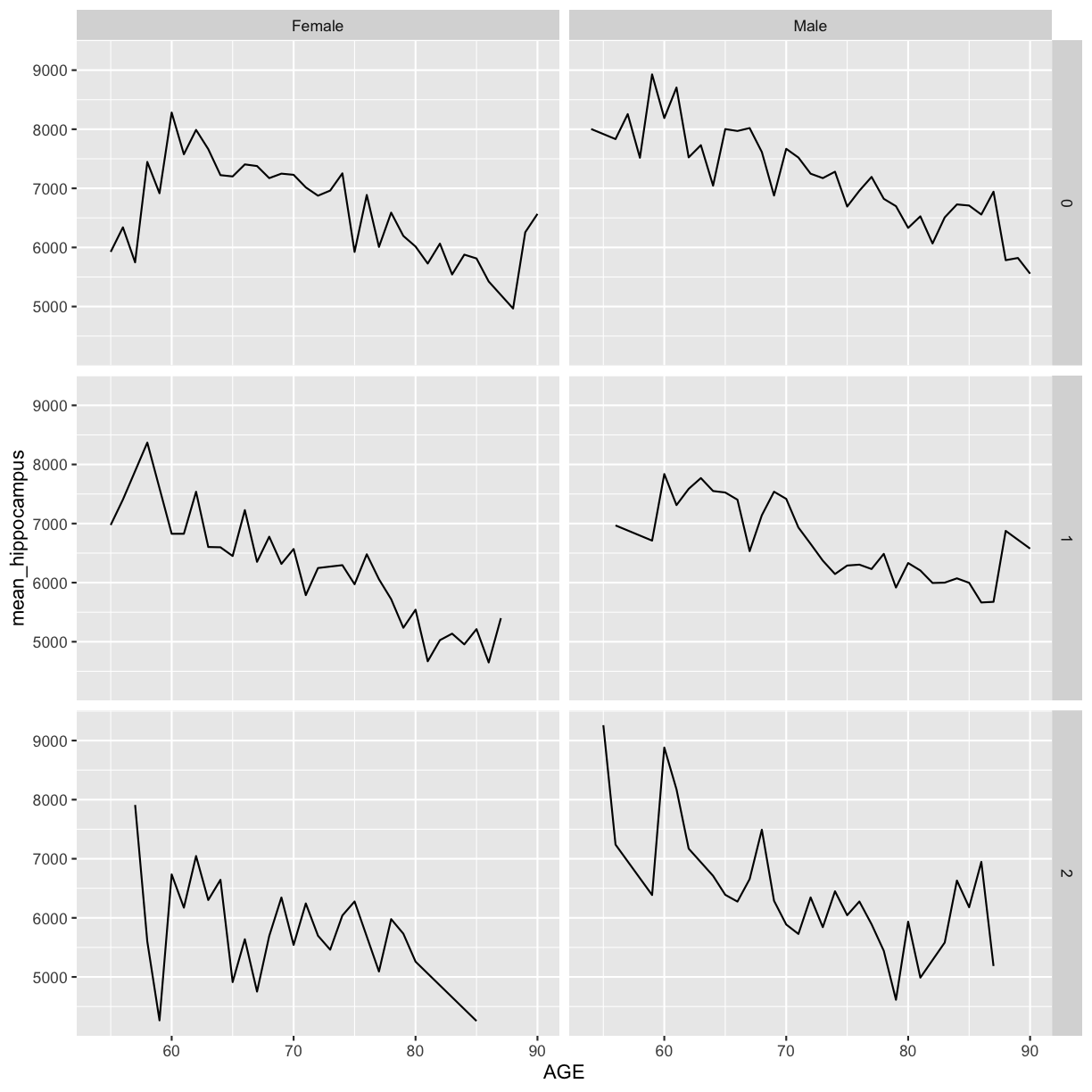
Challenge 4
Take a look at the
ggplot2cheat sheet, and think of ways you could improve the plot.
Customization
Now, let’s change names of axes to something more informative than ‘avg_wholebrain’ and add a title to the figure:
ggplot(data = adni_time,
mapping = aes(x = AGE,
y = mean_hippocampus,
color = PTGENDER)) +
geom_line() +
facet_wrap(~ APOE4)+
labs(title = "Average Whole Brain Volume by Age",
x = "Age",
y = "Average Whole Brain Volume") +
theme_bw()
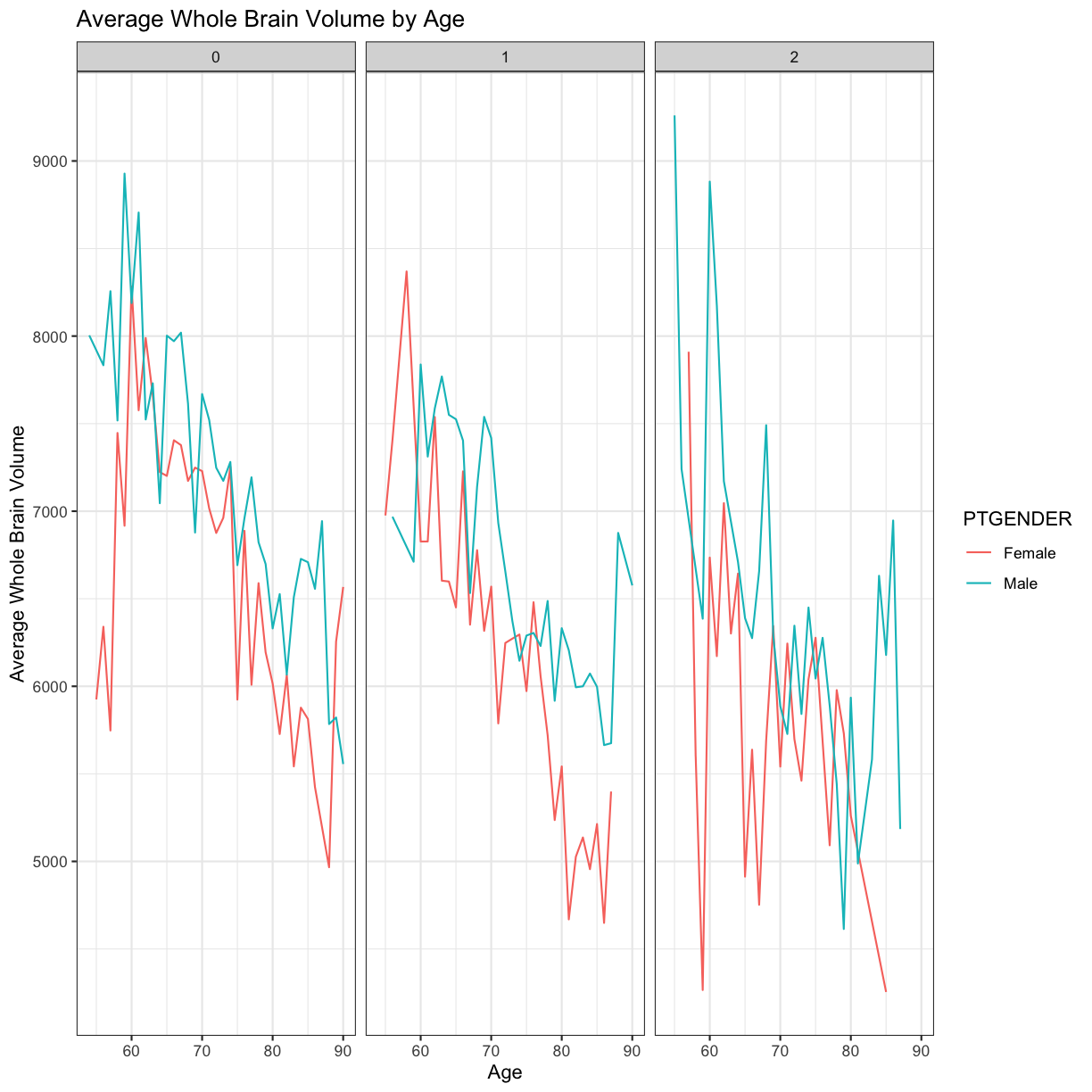
The axes have more informative names, but their readability can be improved by increasing the font size:
ggplot(data = adni_time,
mapping = aes(x = AGE,
y = mean_hippocampus,
color = PTGENDER)) +
geom_line() +
facet_wrap(~ APOE4)+
labs(title = "Average Whole Brain Volume by Age",
x = "Age",
y = "Average Whole Brain Volume") +
theme_bw()+
theme(text=element_text(size = 16))
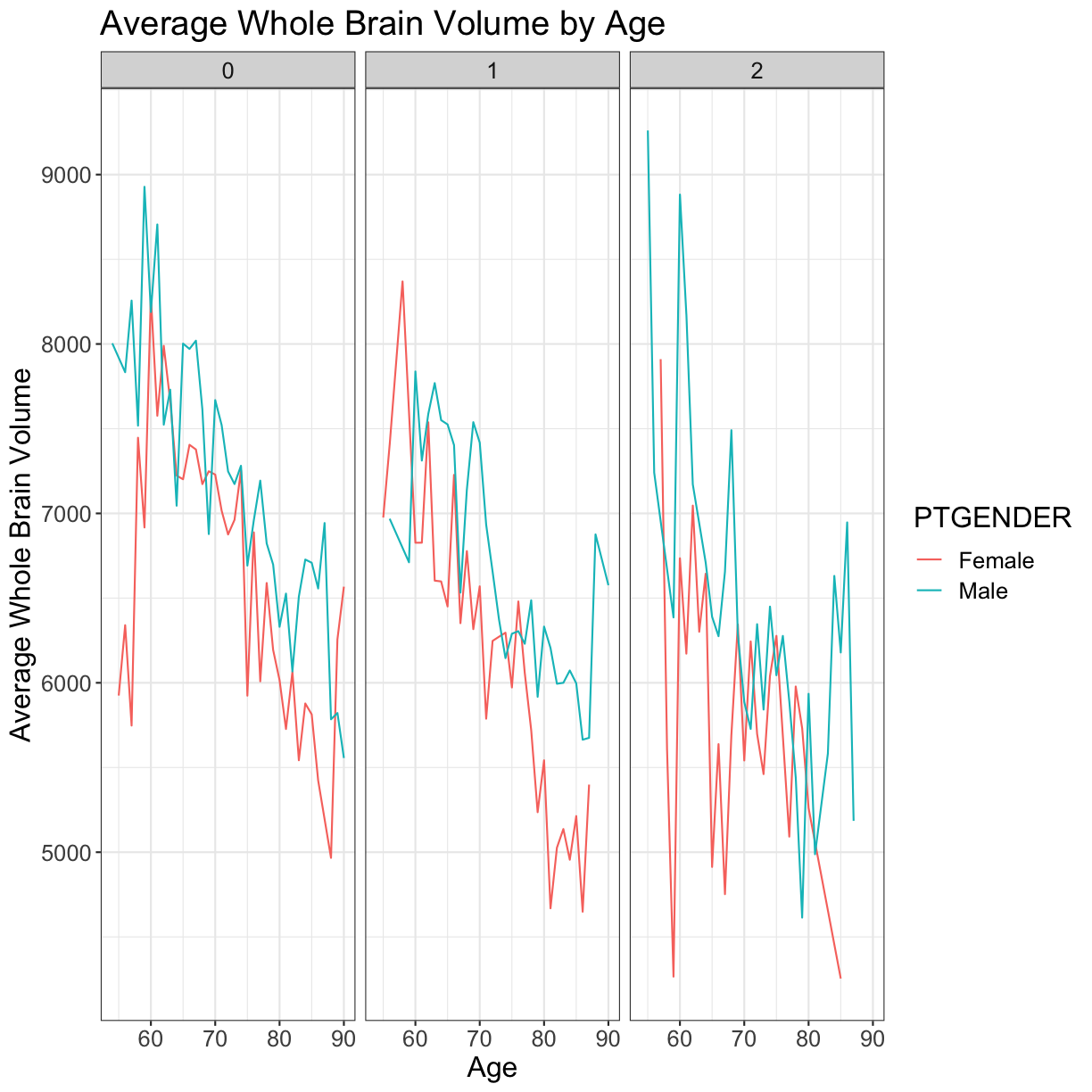
Note that it is also possible to change the fonts of your plots. If you are on
Windows, you may have to install
the extrafont package, and follow the
instructions included in the README for this package.
ggplot(data = adni_time,
mapping = aes(x = AGE,
y = mean_hippocampus,
color = PTGENDER)) +
geom_line() +
facet_wrap(~ APOE4)+
theme_bw()+
theme(axis.text.x = element_text(colour = "grey20",
size = 12),
axis.text.y = element_text(colour = "grey20",
size = 12),
text = element_text(size = 16))
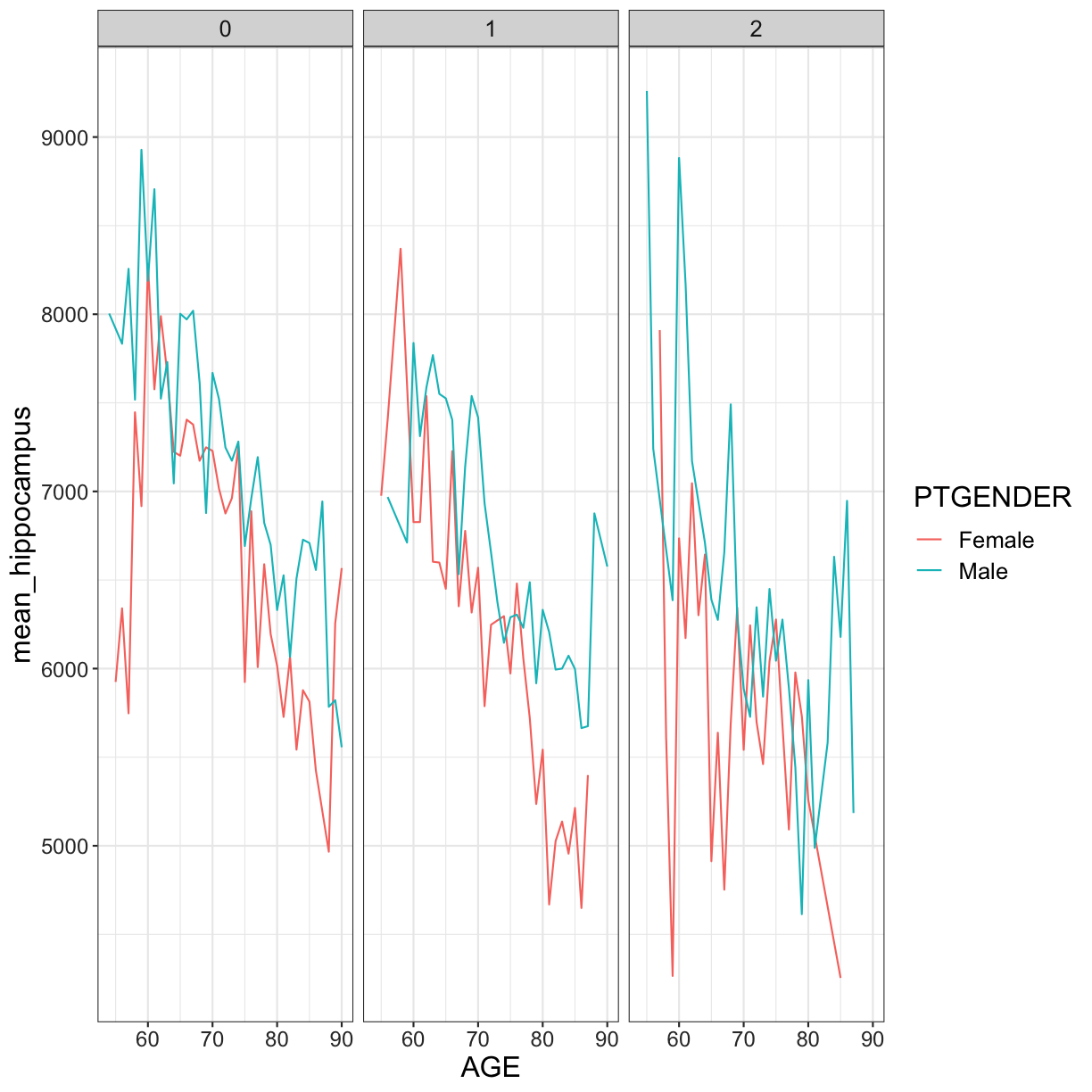
If you like the changes you created better than the default theme, you can save them as an object to be able to easily apply them to other plots you may create:
grey_theme <- theme_bw()+
theme(axis.text.x = element_text(colour = "grey20",
size = 12),
axis.text.y = element_text(colour = "grey20",
size = 12),
text = element_text(size = 16))
ggplot(data = adni_c,
mapping = aes(x = PTGENDER,
y = WholeBrain)) +
geom_boxplot() +
grey_theme
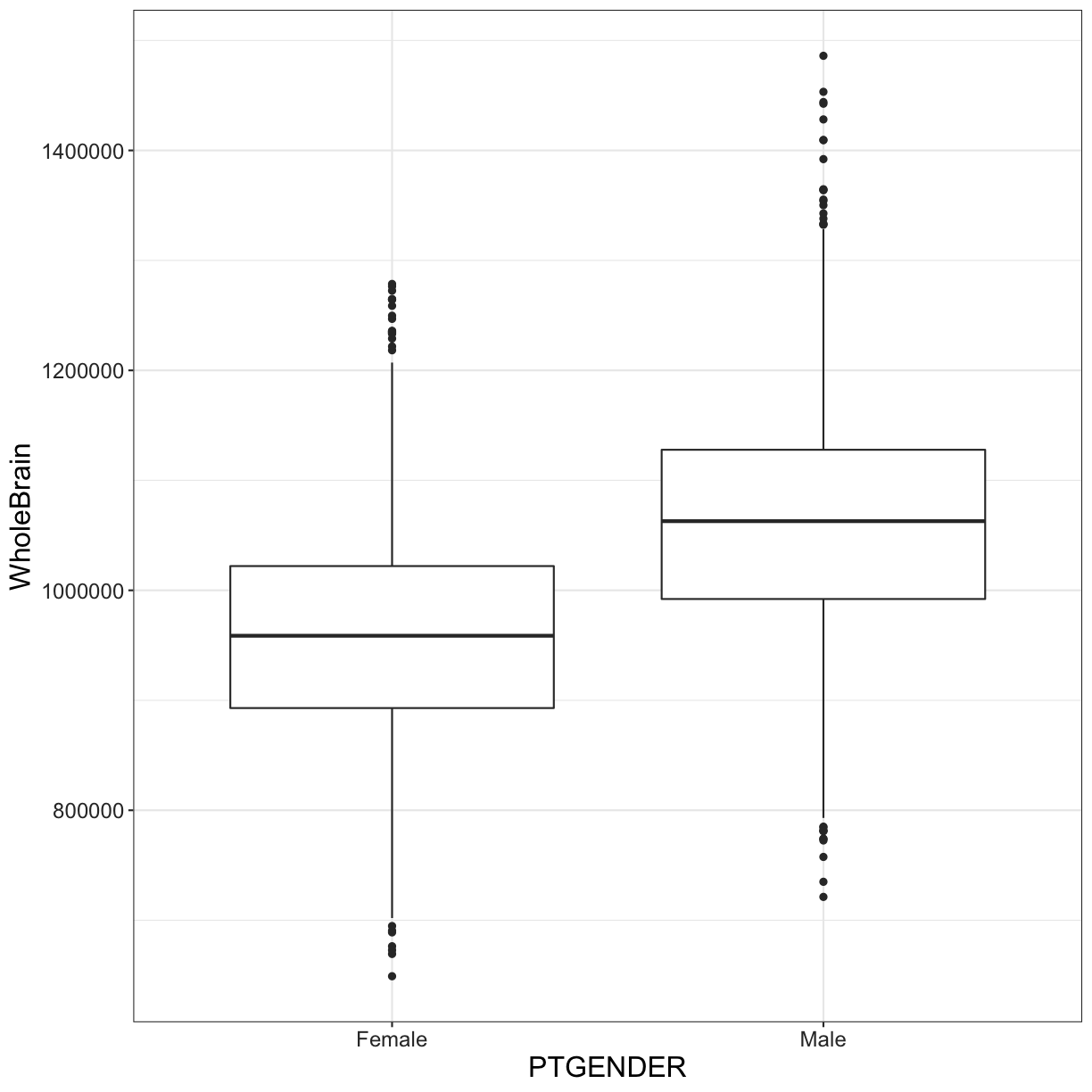
Challenge
With all of this information in hand, please take another five minutes to either improve one of the plots generated in this exercise or create a beautiful graph of your own. Use the RStudio
ggplot2cheat sheet for inspiration. Here are some ideas:
- See if you can change the thickness of the lines.
- Can you find a way to change the name of the legend? What about its labels?
- Try using a different color palette (see http://www.cookbook-r.com/Graphs/Colors_(ggplot2)/).
Arranging and exporting plots
Faceting is a great tool for splitting one plot into multiple plots, but sometimes you may want to produce a single figure that contains multiple plots using different variables or even different data frames. The gridExtra package allows us to combine separate ggplots into a single figure using grid.arrange():
install.packages("gridExtra")
library(gridExtra)
my_boxplot <- ggplot(data = adni_c,
mapping = aes(x = PTGENDER,
y = WholeBrain)) +
geom_boxplot() +
xlab("Gender") +
ylab("Whole Brain Volume") +
scale_y_log10()
my_lineplot <- ggplot(data = adni_time,
mapping = aes(x = AGE,
y = mean_hippocampus,
group = APOE4)) +
geom_line(aes(color = as.factor(APOE4)))+
xlab("Age") +
ylab("Average Whole Brain Volume")
grid.arrange(my_boxplot, my_lineplot ,
ncol = 2,
widths = c(4, 10))
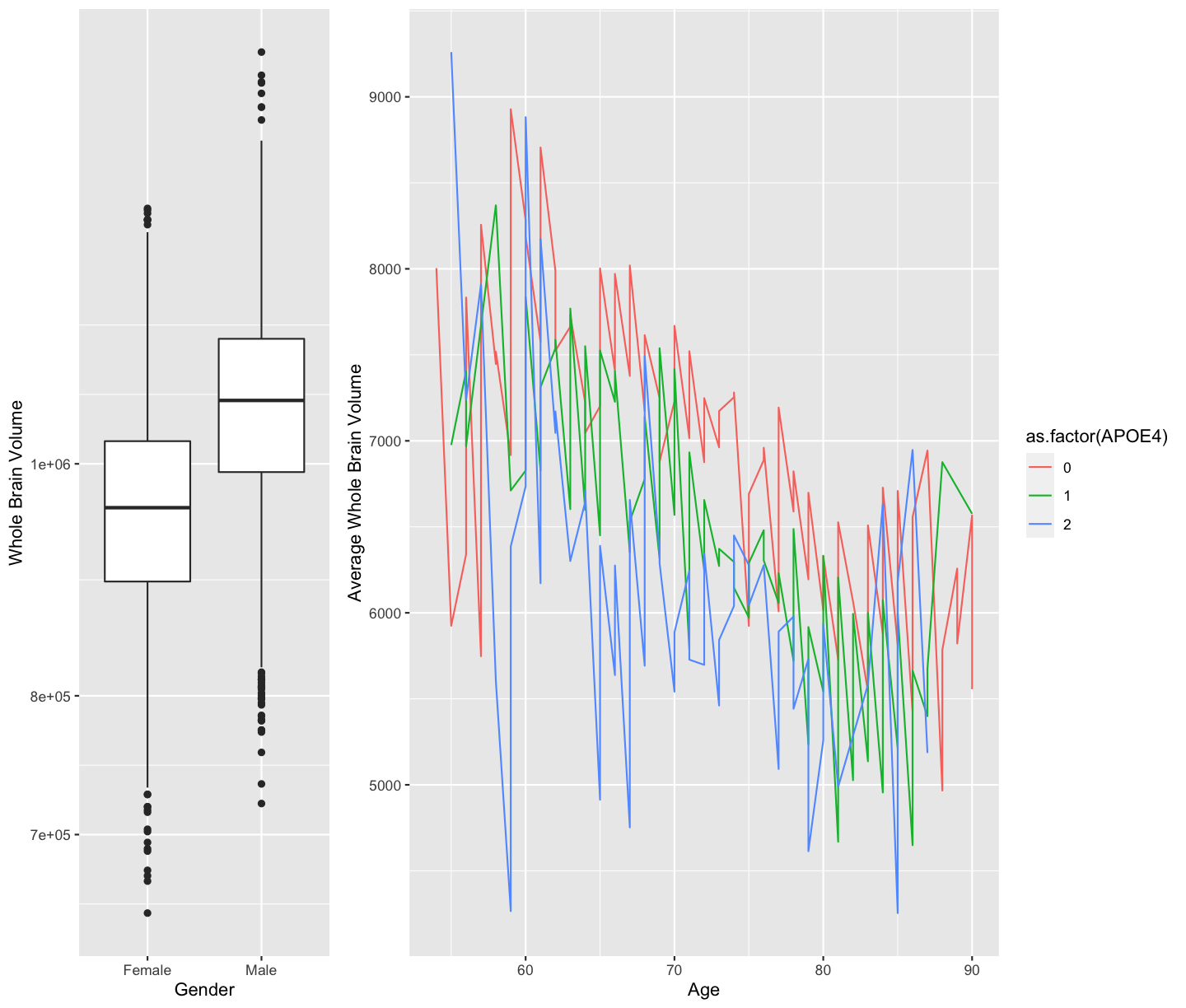
In addition to the ncol and nrow arguments, used to make simple arrangements, there are tools for constructing more complex layouts.
After creating your plot, you can save it to a file in your favorite format. The Export tab in the Plot pane in RStudio will save your plots at low resolution, which will not be accepted by many journals and will not scale well for posters.
Instead, use the ggsave() function, which allows you easily change the dimension and resolution of your plot by adjusting the appropriate arguments (width, height and dpi).
Make sure you have the figs/ folder in your working directory.
my_plot <- grid.arrange(my_boxplot, my_lineplot ,
ncol = 2,
widths = c(4, 10))
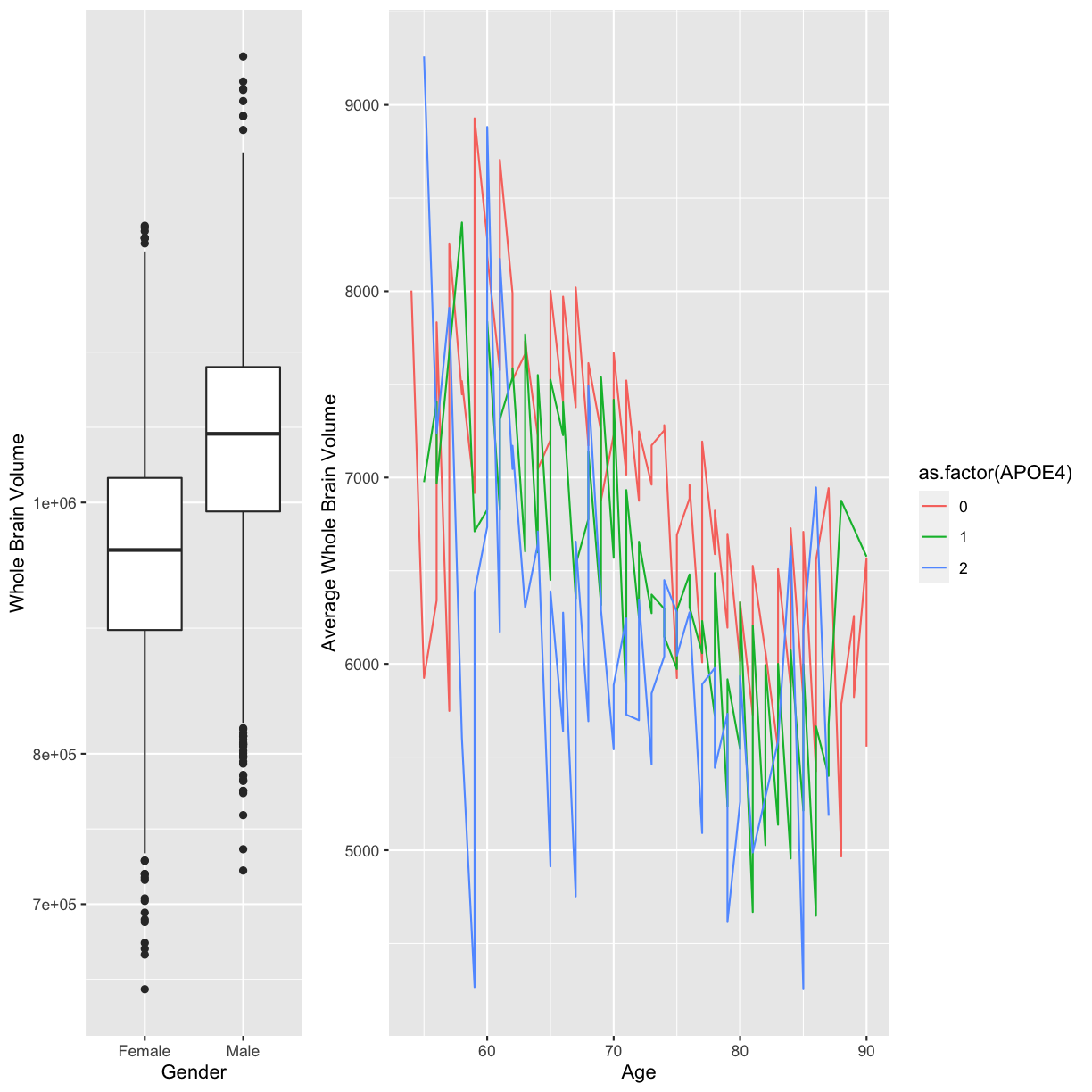
ggsave("figs/grid.png", my_plot, width = 15, height = 10)
Note: The parameters width and height also determine the font size in the saved plot.
Key Points
